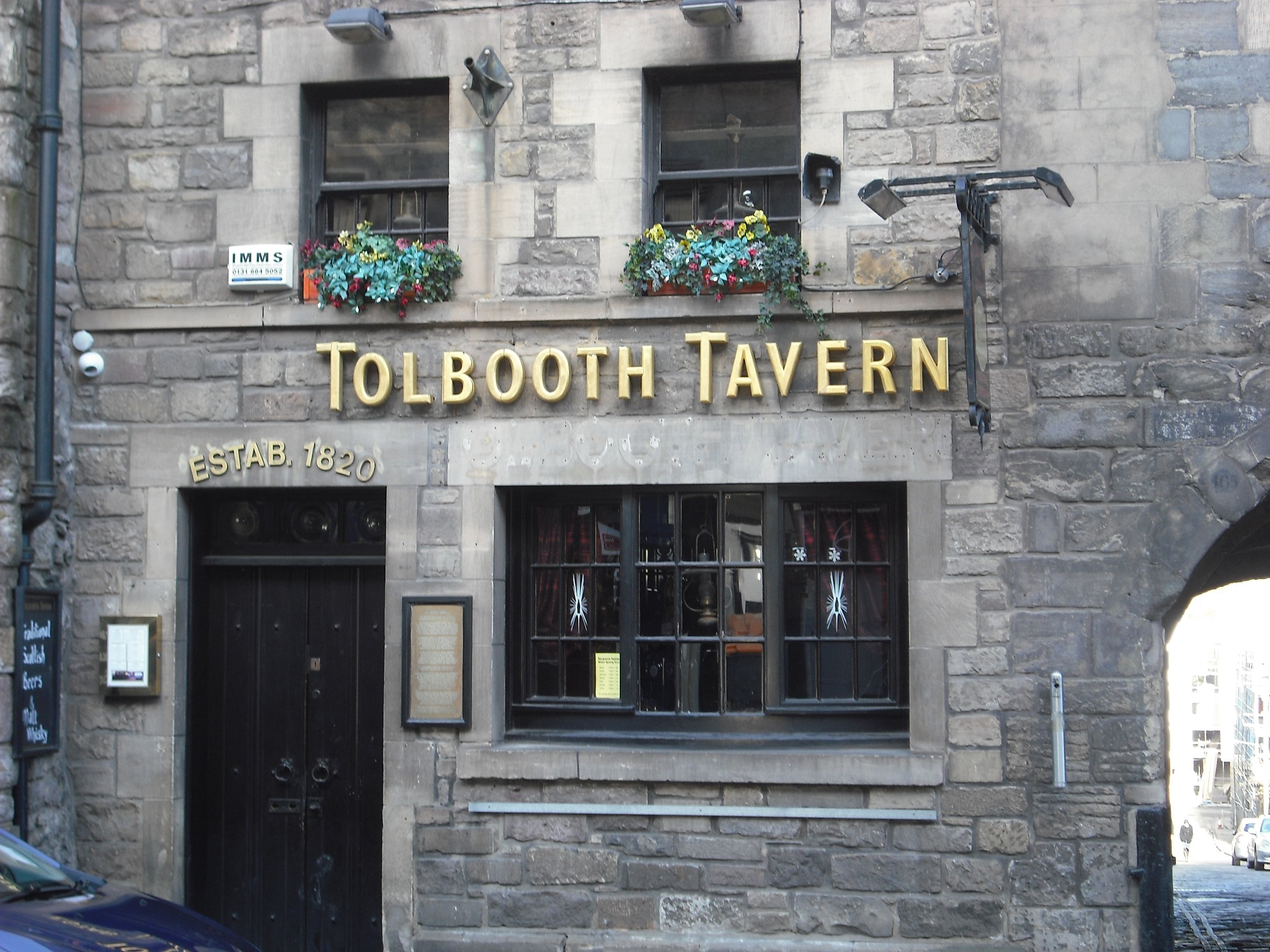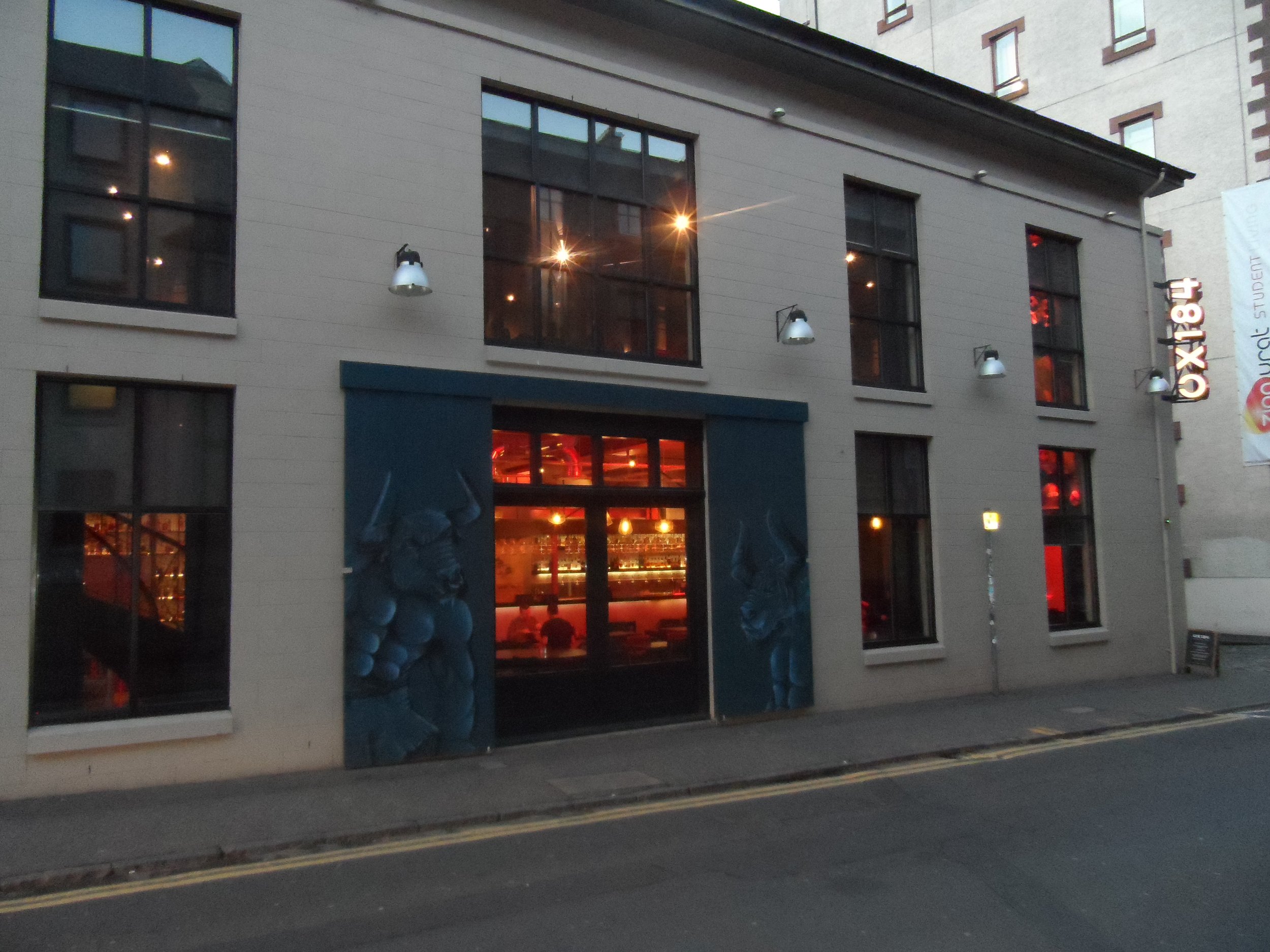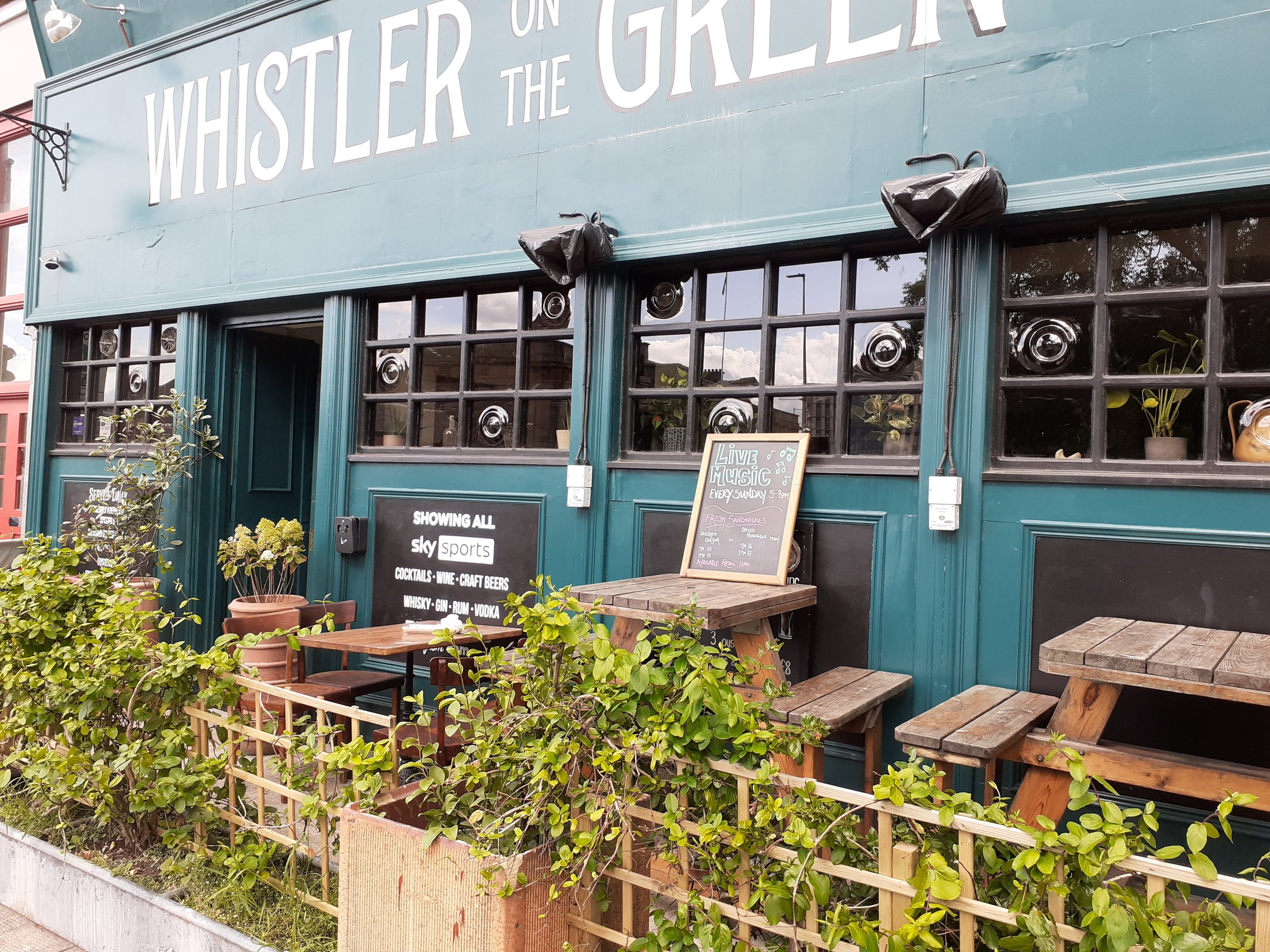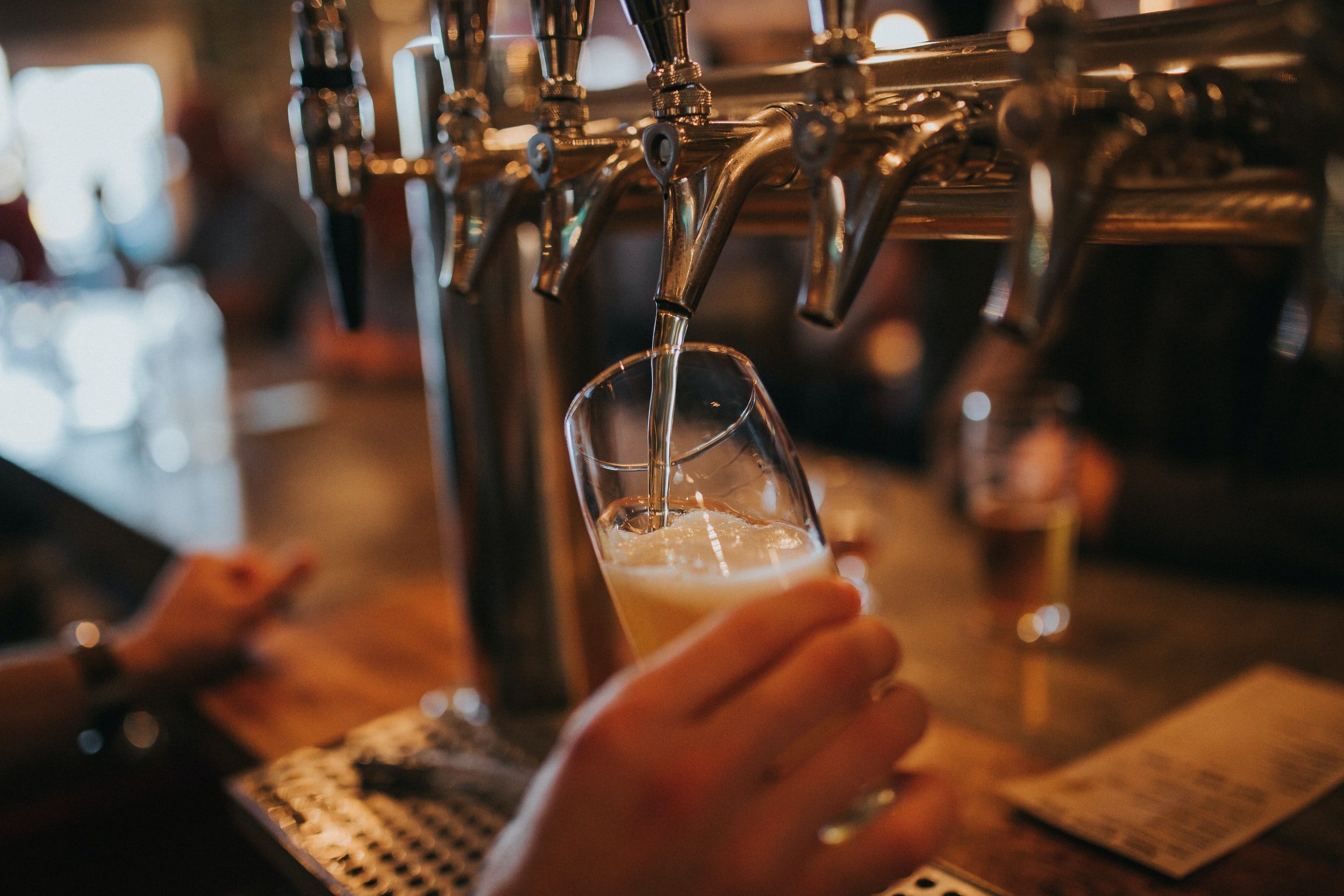
PUBTRAILS
Comparing drinking and pubs in England with Scotalnd
In 1971 I moved my underage drinking from Scotland to Birmingham and discovered the many differences between drinking in Scotland and England. Some of them still exist today although the differences are less pronounced due to movement of people, common ownership of breweries and pubs, TV and film, etc . In fact, many are not particularly noticeable in a modern context but some were in 1971 and more were earlier in the 20th Century.
That there were differences was no surprise since the Parliaments did not combine until the Act of Union in 1707 while brewing, drinking and places to drink in had been in existence long before that and had been having laws and restrictions and taxes placed on them. A lot of differences also come about because of social and cultural issues.

Admiral Benbow, Shrewsbury - not a style in Scotland

The Smiddy, Glasgow - typical ground floor of tenement corner pub
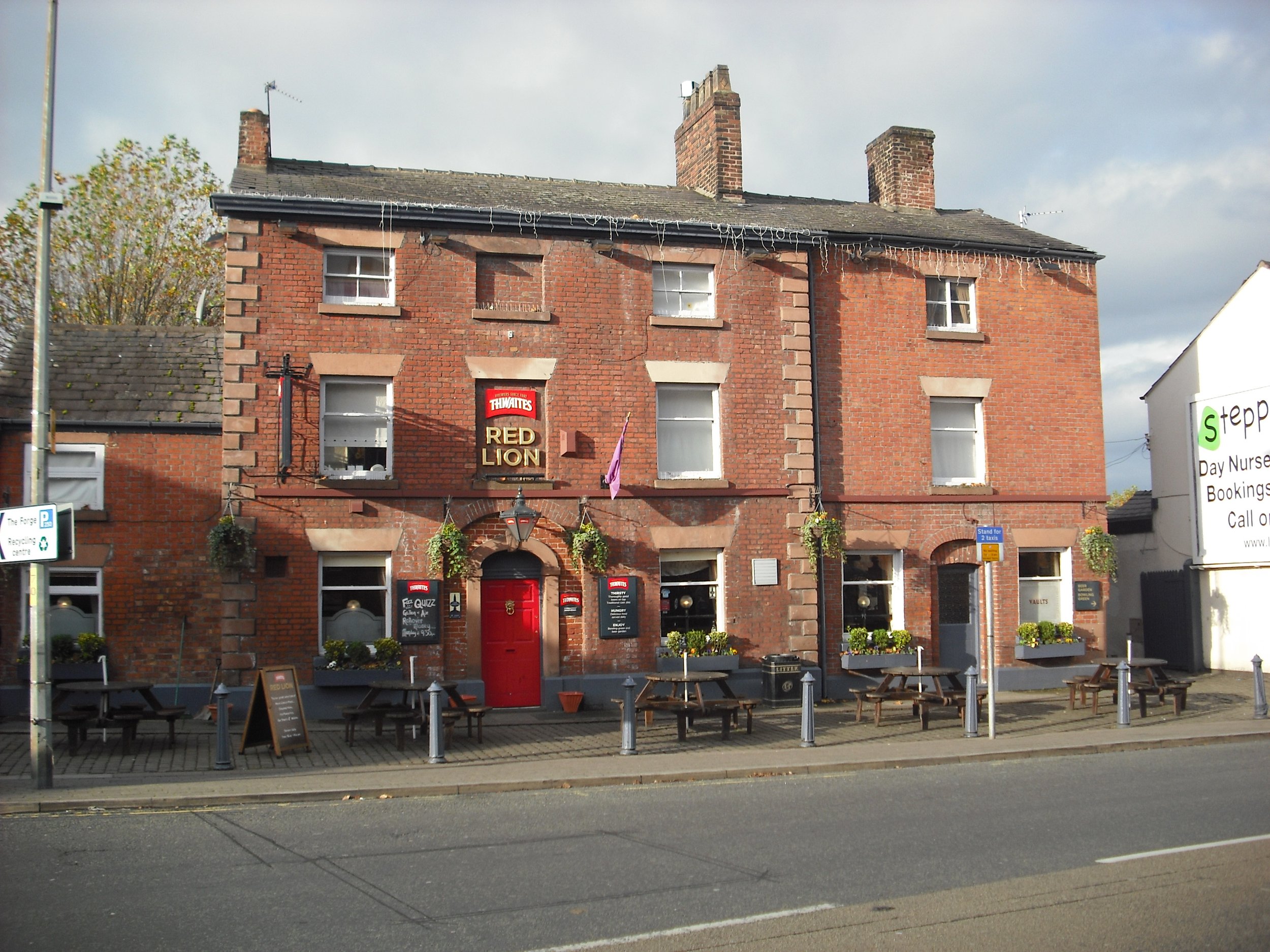
The Red Lion, Stockton Heath - with bowling green to rear (not something found in Scotland)
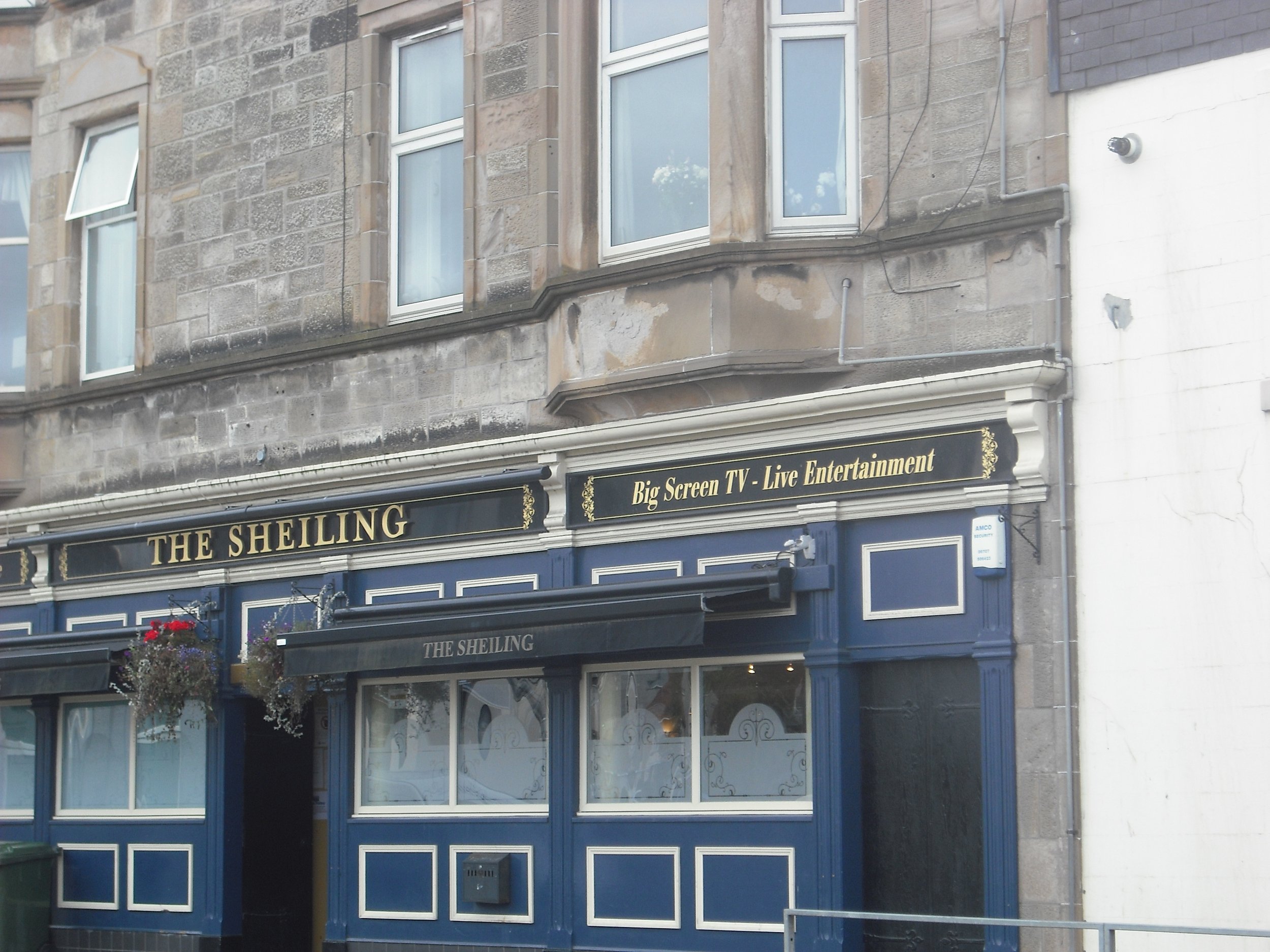
The Sheiling, Largs
Much of the information below has been gleamed from:
(1) People’s Palaces: Victorian and Edwardian Pubs of Scotland By Rudolph Kenna and Anthony Mooney, Pub Paul Harris, 1983
(2) A History of Drinking: The Scottish Pub since 1700 by Anthony Cooke, Edinburgh University Press, 2015
Plus help from
(3) Licensed to Sell, Geoff Brandwood, Andrew Davidson & Michael Slaughter, English Heritage, 2004
(4) Scotland’s True Heritage Pubs, ed Michael Slaughter, CAMRA.

Scotland's True Heritage Pubs - ed Michael Slaughter

A History of Drinking: The Scottish Pub since 1700 - Anthony Cooke
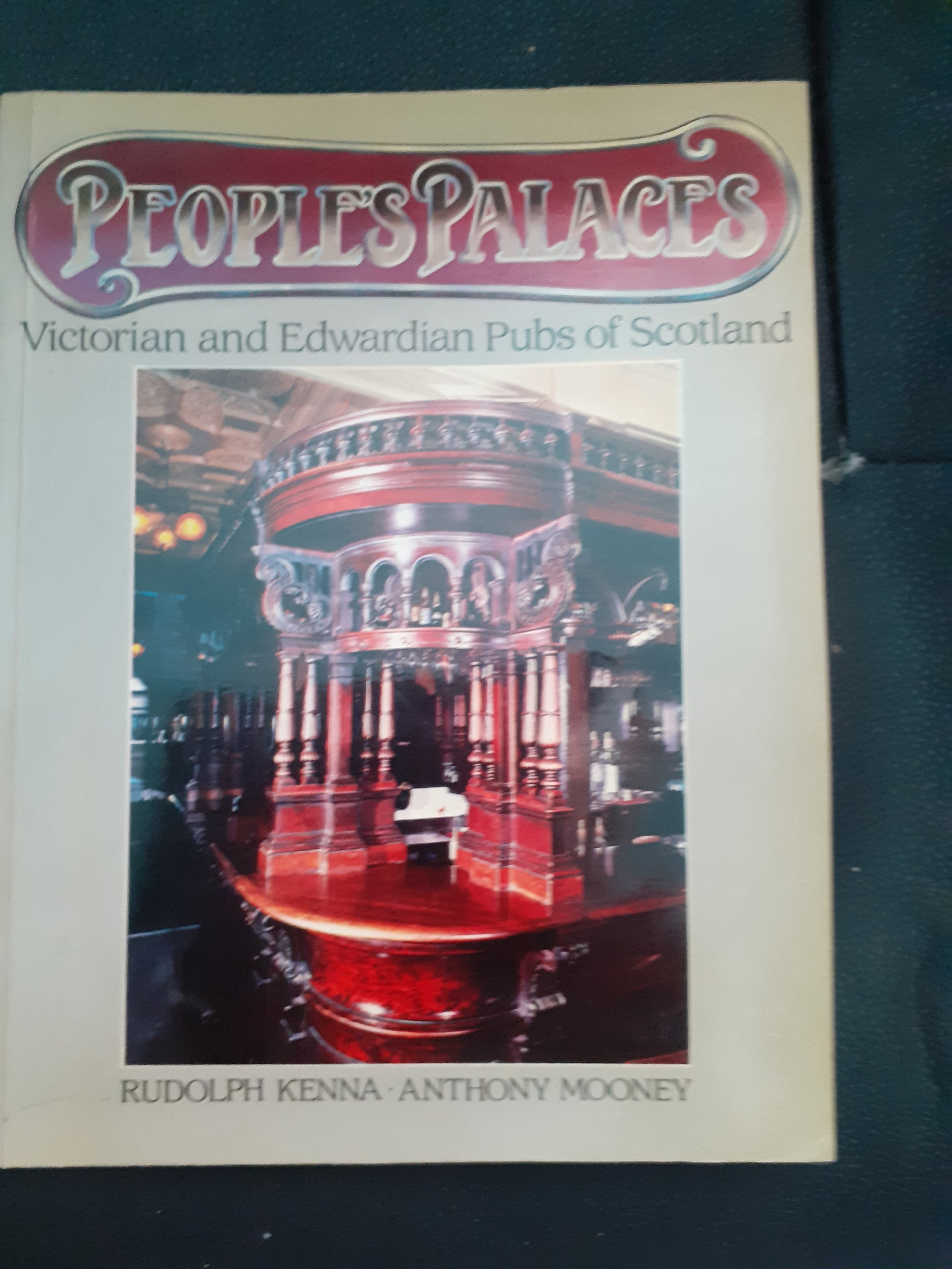
People’s Palaces: Victorian and Edwardian Pubs of Scotland By Rudolph Kenna and Anthony Mooney

Licensed to Sell, Geoff Brandwood, Andrew Davidson & Michael Slaughter
Differences to me were sometimes as obvious as different styles of beer and licensing hours, to the actual architecture and design of pubs, the dispensing of beer, tied houses and even the naming of drinking establishments. None of the differences caused confusion as to how or where to get a drink, however, they are interesting and, of course, generalisations.
Outlining the differences
1. Naming places - pub or bar?
2. Licensing hours in 1971- early closing and pubs not opened on Sundays
3. Architecture -styles of buildings and internal supervision
4. The Tie- Free trade in Scotland
5. Naming Beers -Heavy or Bitter
6. Dispensing Beers - handpump or water pressure
7. Taste
8. Open air drinking - Not designed for Scotland
9. Extending drinking hours 1976 - Scotland get extended opening before England
10. Smoking ban
11. Still fighting alcohol
12. A little History
a) Before the Union
b) 1700s
c) Late 18th and Early 19th Century
d) Temperance – Starts in Greenock
e) Victorian & Edwardian
f) Defence of the Realm
g) 1918-1945
h) 20th century - adding more controls
PLACES TO VISIT WITH PUBTRAILS
The towns and villages highlighted on this web site have a wide variety of pubs and beers in them. All of the places are great to visit, whether for a day or longer, and most have tourist attractions for all of the family.
There is a large variety of pubs throughout the different towns shown below. Some you may wish never to visit again but even discovering these can be interesting. There are pubs that you would not take your wife into. While some you could not take your girlfriend into. A few you would not take either into. However, most of the pubs are very pleasant.
HOME MAP of places visited
Alnwick Ambleside Anstruther Bakewell Bamburgh Barnard Castle Bath Berwick upon Tweed Birnam & Dunkeld Bourton on the Water Bowness on Windermere Bridge of Allan Chester Chichester Dunblane Dunoon Edinburgh Ely Fort William Glasgow Gourock Helensburgh Inverness Kelso Keswick Knaresbourgh Largs Linlithgow Lyme Regis Melrose Montrose Newton Stewart North Berwick Norwich Oban Pebbles Penzance Portree Pitlochry Quorn Richmond Rothesay St Andrews Seahouses Seend Shrewsbury Skipton Stirling Stratford-upon-Avon Stockton Heath Whitby Windemere Whitstable York
1. Naming
In naming where people drank Scotland was a little different. Brandwood, Davidson and Slaughter in Licensed to Sell point out that in Scotland people went to a bar for a drink; in England to a pub or public house with a bar being the servery counter as in “standing at the bar”. Although as time has gone by the distinction is less in use and it is unlikely that an Englishman would not understand what an invitation to visit a bar in Glasgow meant.
Many bars in Scotland are historically called after the licensee, who was probably the owner, and/or have the word “bar” in the name.
The English naming is much more helpful; the pub is the building while the bar is counter that you get served at. Because I use both bar and pub as the building I am left foundering when describing the “bar of the bar”, therefore I tend to use servery (as recommended by Brandwood, Davidson and Slaughter) or counter.
Many bars were named after their owner as few Scottish bars were owned by breweries compared to in England. Even in 1969 when 86% of English pubs were owned by a brewery, it was only 27% in Scotland. The majority were owned or rented as a sole concern. Although there already were the start of pubcos as some businesses owned a group of pubs.
Scotland always seemed to have a feeling for hiding the demon drink. Many drinking places were down closes. Licensees were not allowed to live above premises, earlier evening closing than England and Sunday closing of pubs.
Post Office Directories in England list names of pubs while those for Scotland give the name of the owner/renter who is called a “ wine and spirit dealer”. For 1890 the POD for Greenock has 137 places selling drink and only 37 have a bar or hotel name the rest are under Spirit Dealers.
A less than subtle difference seemed to be that Scottish Bars emphasised drinking rather than socialising and particularly the drinking of spirits rather than beer.
Macsorley’s a ground floor bar in a tenement block with other tenement blocks on either side. Named after the owner it has glass that cannot be seen through and a double door entrance. No outside seating available in middle of city.
Though it does have an apostrophe - this is often missing
2. Licensing hours
The most obvious difference between the countries in 1971, were the licensing hours. Differences in opening hours lasted until 1988 when English hours eventually caught up with Scotland’s.
Meanwhile in 1971, however, England opened pubs on a Sunday, while in Scotland only Hotels opened on a Sunday. Bars had been closed on a Sunday in Scotland since 1853 while Hotels had been allowed to open and could serve those staying there and/or bona fide travellers from three miles or more. England narrowly avoided this fate in a vote in 1881.
The “bona fide” traveller being allowed to drink on a Sunday was pushed to the limit. Travelling became very popular on Sundays with these trips associated with heavy drinking. If you were making an effort to travel for drink, then you were going to make sure you drank. Drunks on board boats on the River Clyde were nothing new but travelling on a steamer down the river Clyde on a Sunday became more popular after 1853. ‘Steaming’ as a word for drunk comes from these trips. This was finally stopped in 1882 by the Gladstone Act forbidding the sale of alcohol on passenger ships on a Sunday. This problem, of people travelling to hotels miles away and getting drunker than if at their closest pub, still existed up to 1977.
Lord Guest’s report part 1 (1960) had recommended Sunday opening for pubs, hotels and licensed restaurants but this was rejected by the government. Instead, weekday opening was set at 11.00 to 2.30 and 5.00 to 10.00 and Sunday for hotels and clubs 12.30 to 2.30 and 6.30 to 10.00. And so it stayed until 1976.
In the 1962 Licensing (Scotland) Act, hotels were now allowed to sell to the general, non-travelling, public. Although the belief of requiring to be a traveller stayed as an urban myth. In practice most people actually did have to travel to get to an open hotel anyway. Private members clubs, much to the annoyance of publicans, could also open on Sundays.
This travelling to get to a hotel caused issues for the police because drinkers were being attracted to establishments outside of where they lived, which then became very busy and so there was over-drinking caused by people insisting on drinking more than usual as they had had to travel in the first place.
An Act in 1903 had imposed evening closing set at 10pm with 10 minutes drinking up time while in England it was 11pm closing in most places. About ten minutes before “last orders” was called drinkers would go up for a last round and probably order two rounds. These all had to be drunk in the twenty minutes left. This was more difficult than it sounds because everyone was doing it so it might be 9.59 before you were served giving only 11 minutes for two rounds and what had been left on the table when the last orders call went out.
The staff suffered abuse at not serving quick enough or for asking customers to leave. Staff were sometimes only paid to 10pm as that was when the bar closed. More generous employers might pay till 10 past 10 and a really good employer would pay till half past ten as apart from chucking people out tables had to be cleaned and glasses washed up. Cleaning and stocking shelves would, hopefully, be a morning staff job.
Of course, this all meant that at 10pm the streets outside of pubs were busy with people trying to get home. Two or three pubs close together meant large numbers of folk ranging from tipsy to drunk milling around. Many of these had just had a sudden influx of alcohol from the double round bought at the end of the night. Perhaps some had taken arguments inside the pub to the less controlled outside or perhaps drinkers from different pubs started an argument.
A similar, but less frantic 11 o’clock dive for last drinks occurred in England.
Less well known, and though not as common, but perhaps more destructive was the “Five o’clock swill” experienced in heavy industry areas eg close to shipyards.
Many bars near large workforce industries were ready for a small invasion of workers as they finished work at 5pm and the bars opened at 5pm. To prepare for this invasion bars would pour out about seven to ten half-pints and sit them on a tray then balance another tray on this and set up another load of drinks. Similarly, there would be layers of pints of beers, whisky, and perhaps the biggest pile of trays containing ‘dark’ or ‘clear’ ie red or white fortified wine. By the 1970s the fortified wines were more likely to be South African, and were called names like Eldorado or Four Crown. These were still being sold in pubs in the 1980s although the five o’clock swill long ended as industries closed down.

Richmond, Yorkshire has a large square where currently (there have been more) six pubs would empty at the same time plus several up roads off of the square if closing times were exactly the same.
There was also the example of Australia where pubs had to close at 6pm. Workers finished their work at 5pm leaving an hour for drinking which resulted in the six o’clock swill. Stories abound about bars staff hosing beer into glasses - lots of spillage, lots of sick, lots of quick profit - so people could get all their drinking done in the 60 minutes. Of course people getting very drunk in an hour and the associated behaviour did fuel temperance calls for keeping bars closed. “If they could get this drunk in an hour …..”
In all of the countries those against extended hours saw evidence to support them without looking any deeper into what was occurring with a single closing time, afternoon closing and short drinking times. Extended closing means that people drift away from pubs as the night gets late rather than all exit at the same time.
Some towns in Scotland, like the Local Authority of Inverclyde which has Greenock as its largest town, when allowing extended opening included a curfew for people moving moving between pubs creating a time when lots of people were milling about the town centre shifting bars. Over the years this has shifted from 11pm to 11.30pm to midnight. This also meant people were more liable to stay in a particular bar; after all you could not leave and then decide to go to another. It also meant trouble in a bar stayed in the bar rather than leaving it.
On 18th Sept 2023 Inverclyde decided to scrap this curfew after police admitted there was no evidence that this had had any positive impact. Had evidence been presented at any time for the curfew since 1994?
Yet again, during the Covid crisis and the eventual reopening of pubs under restrictions the authorities went for all bars closing at the same time. So again lots of well oiled people hanging around outside pubs at the same time and creating a taxi shortage and bus services packed. While the police were stretched between all of the pubs and also looking for house parties. Of course most of the arguing outside of pubs was probably about Covid and the government’s handling of the situation.

The Bow Bar, Edinburgh - like a shop front
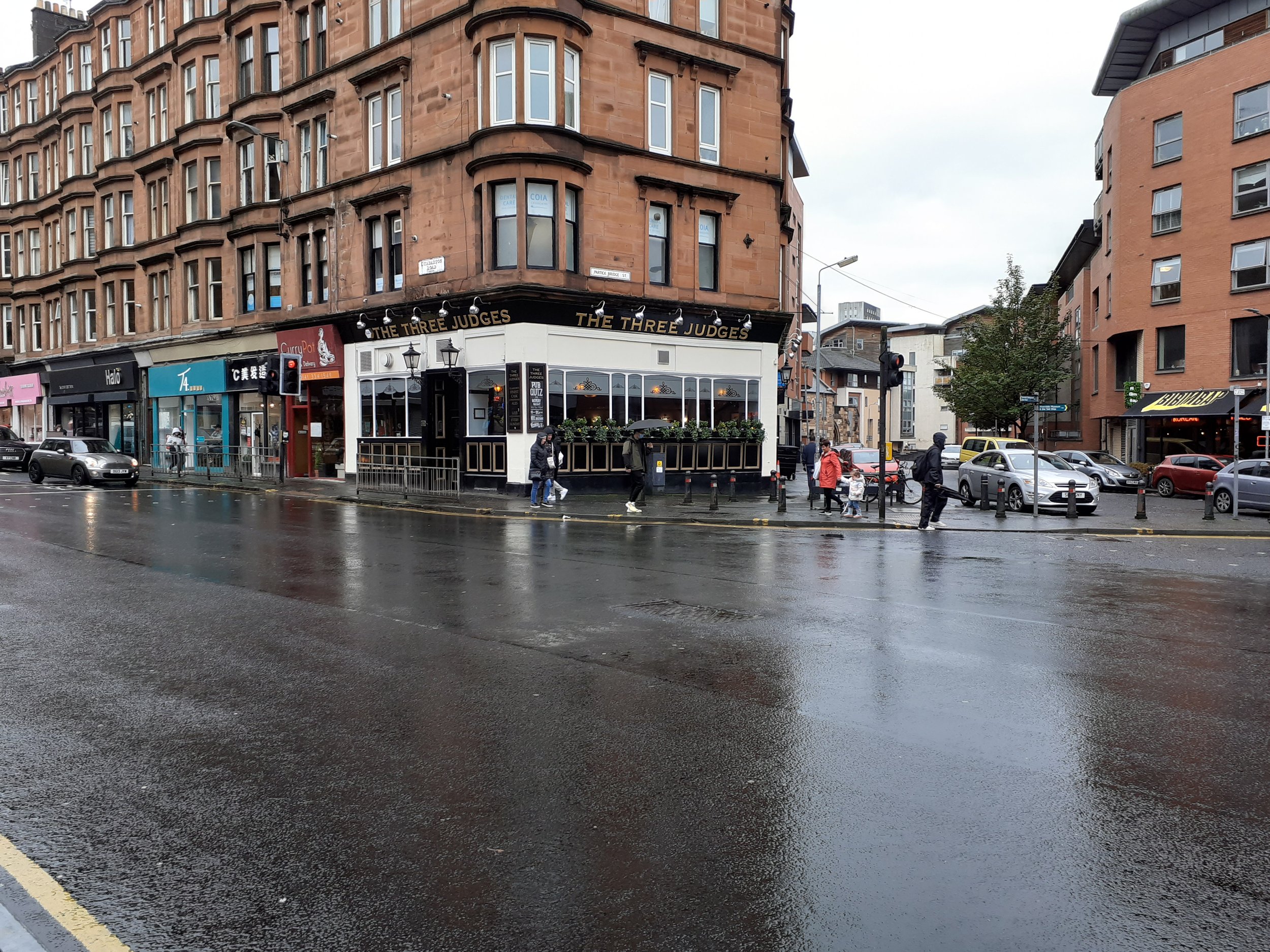
The Three Judges, Glasgow - tenement flats above

The Jolly Judge, Edinburgh - down a close
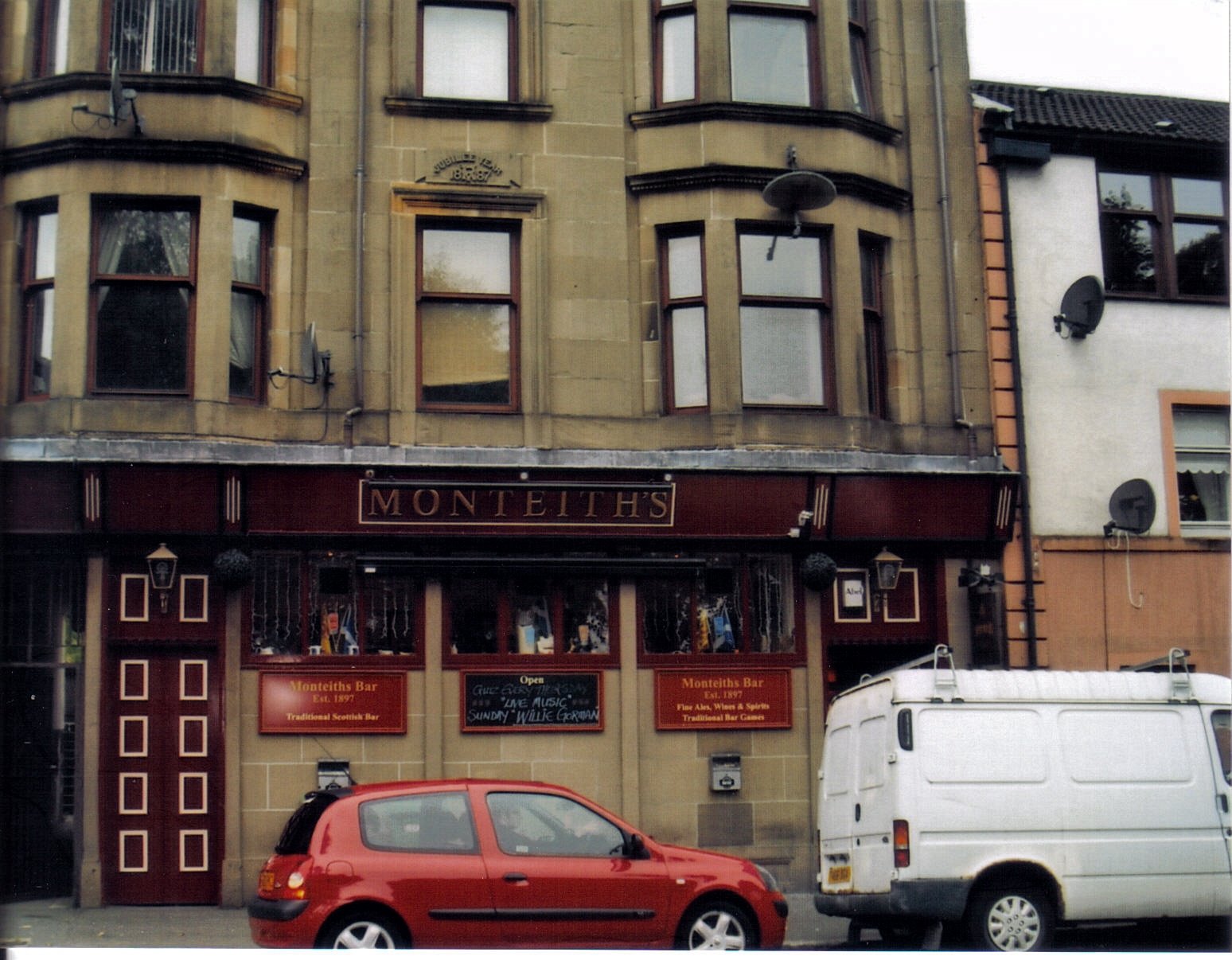
Montieth's, Gourock - flats above and high windows
3. Architecture
Few urban bars from before the late 19th Century have survived in Scotland. The years 1850 to 1910 became important in the building and redesigning of bars as new licensing laws were introduced on the back of the temperance movement, Sunday protectors and concern for drunkenness and associated crime.
One of the most visual differences comes from the architecture. In Scotland’s cities and towns the most common housing structures are tenements. These are three to four story high buildings usually built side by side with six to eight flats in them as homes. These apartments could be small two roomed affairs to a flat having large well proportioned rooms of two public and four bedrooms and possibly a butlers pantry. In the centre of towns and cities the lowest floor of these buildings, sometimes, instead of containing homes were in fact shops – butchers, grocers, sweets, newsagents etc. Sometimes one of these shops was a small bar. Calling a bar a shop or a ‘wine & spirit merchant’ disguised the fact that alcohol was drunk on the premises. Scotland went to many extremes to hide alcohol drinking.
This tenement structure for bars meant that they did not have any living accommodation attached for the publican above the pubs. Publicans living above bars was actively discouraged to avoid people staying in the bar after closing. A member of Joe Public lived up above the bar which could not have been the quietest flat in the building. Scottish bars would have a long counter with plenty of standing room (seats encouraged people to drink) and usually had a number of semi-private rooms off of the main area. Often these small rooms were unable to be seen from the bar counter leaving behaviour unsupervised.

The Mulberry Tree, Stockton Heath
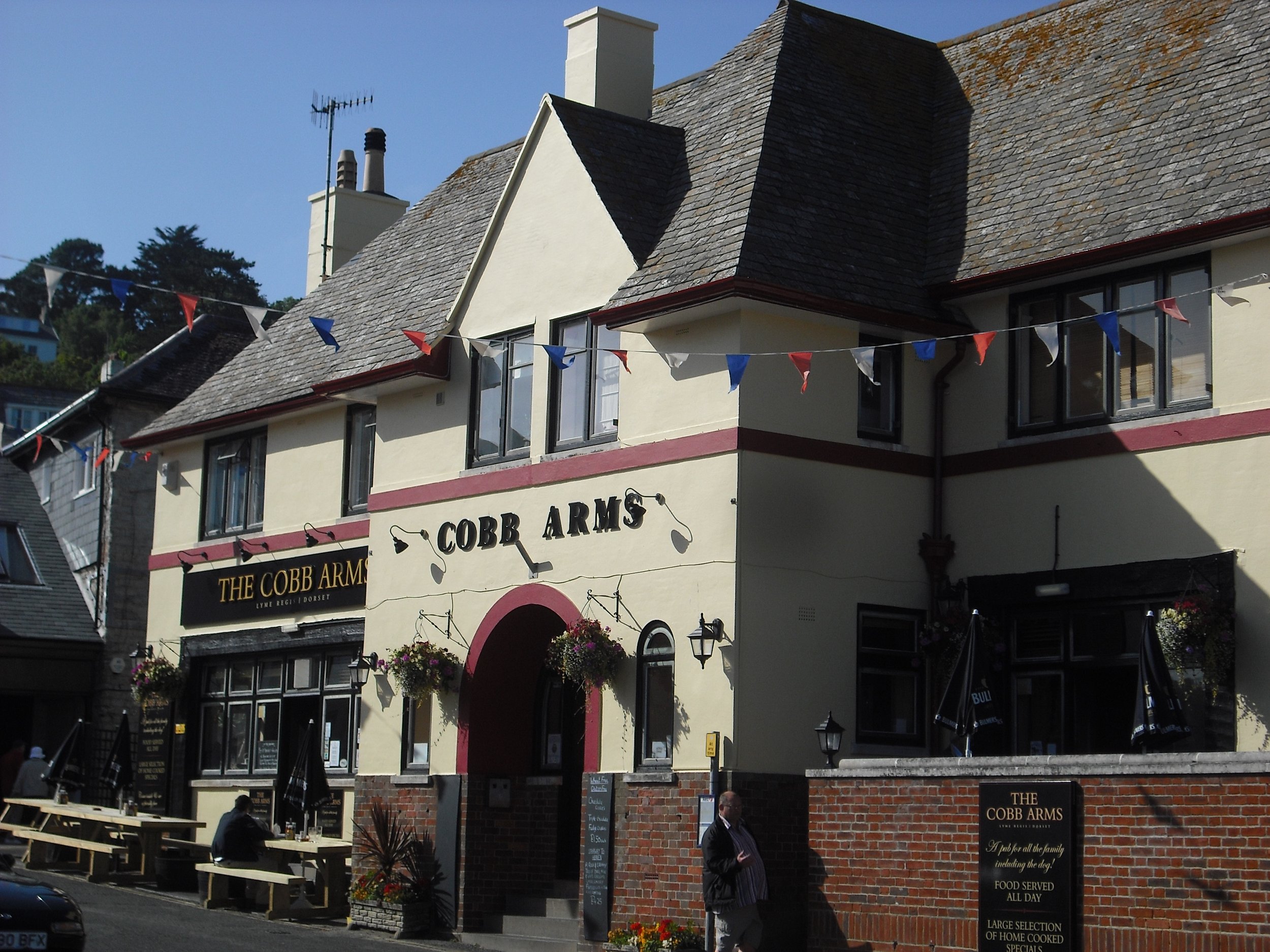
The Cobb Arms, Lyme Regis

The Unicorn, Ambleside
In England buildings were usually built as public houses and many were very large with the landlord staying on the premises. While there may have been drinking rooms they were all served from the same counter.
Traditionally Scottish pubs had very little window space. Windows, if they existed were at high up on the frontage and maybe darkened, perhaps a curtain drawn across or the glass covered in name or advertising. This made the inside short of natural light, especially if the bar had a narrow frontage and lengthy interior. This was so that people could not see into the bar and witness drunken behaviour, or worse, be tempted to enter. However, it also hid anything illegal happening from the outside.
At the start of the 20th century Liverpool had reduced drunkenness by regulation of the internal layout of pubs and by enforcing opening hours. Magistrates from Glasgow (1902) and Dundee visited and were impressed by being able to see into pubs via windows that were not curtained or obscured and by looking in a door you could see most of the pub interior. Scottish pubs often had a small porch and thus two sets of doors running interference on supervision. Liverpool pubs had no semi-private compartments. The fact that most pubs were brewery owned in Liverpool made them easier to control as the breweries had a vested interest in good behaviour in pubs and magistrates threatening one pub could have others owned by the brewery in their sights. Liverpool had pubs on main thoroughfares rather than up back closes. Bars in back closes may have hidden the bars from tempting others but this also hid misbehaviour. After this visit Dundee magistrates recommended that bars be removed from alleys and closes and shifted to thoroughfares for better supervision.
Taking on board the information from Liverpool would have caused Scottish licensing authorities’ sleepless nights as their main aim seemed to be to take any “enjoyment” out of bars and to leave them hidden away lest they tempt others.
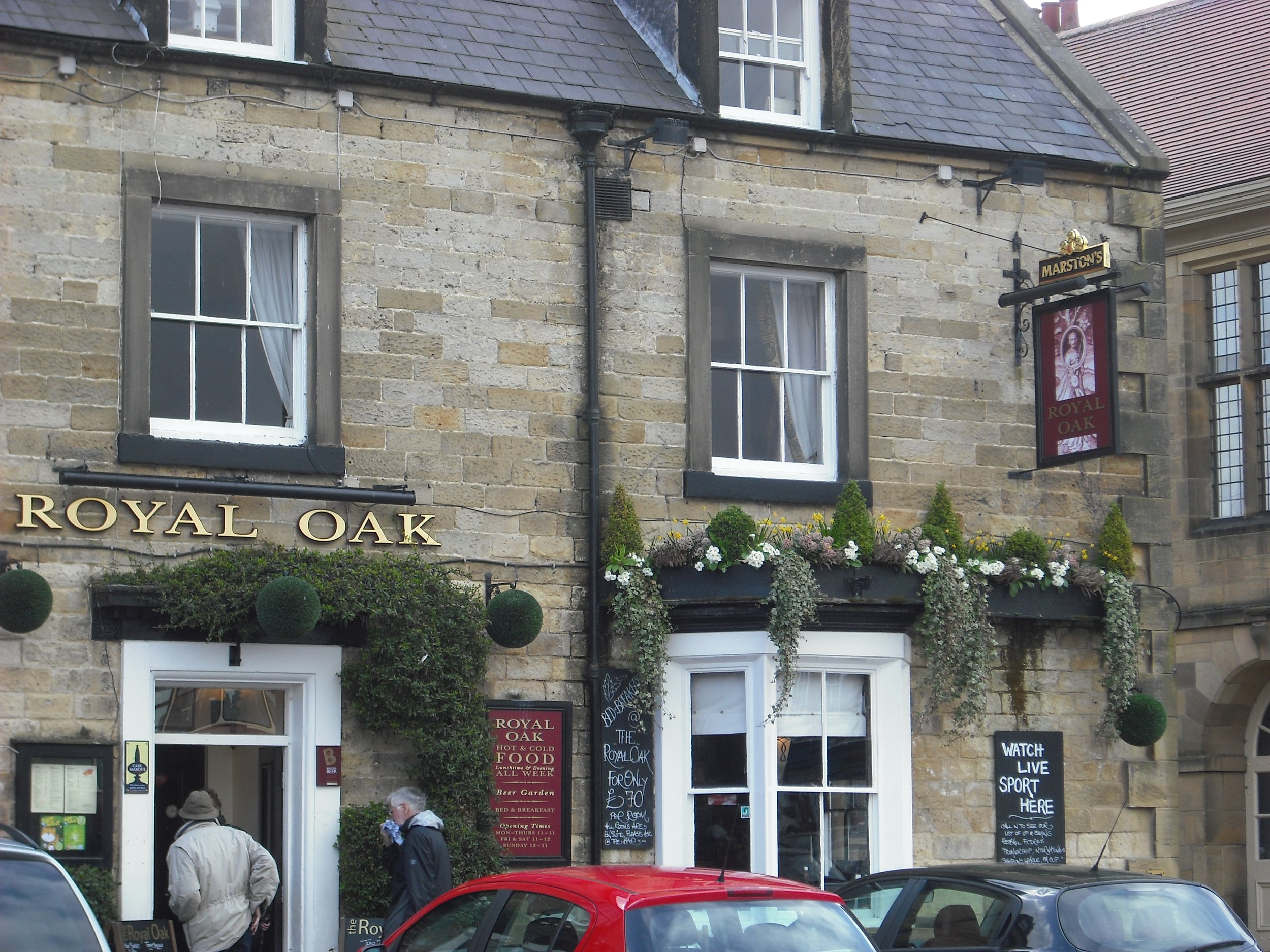
The Royal Oak - not a pub structure seen in Scotland's towns
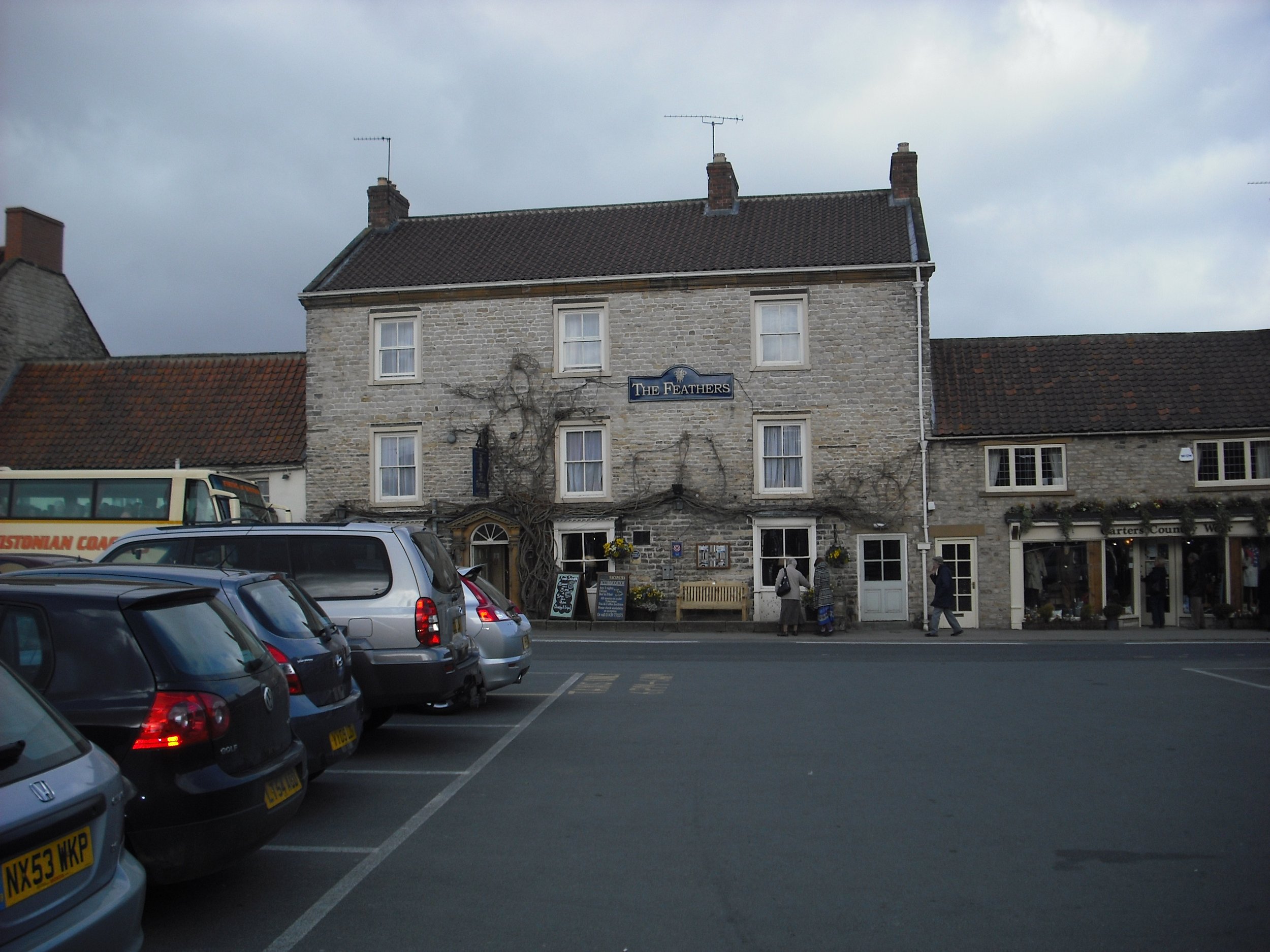
The Feathers - not a pub structure seen in Scotland's towns

The Shire Horse - not a pub structure seen in Scotland's towns
1903 Licensing Scotland Act
This Act made it an offence to supply children under 16 with alcohol (previously 14), licensing authorities could fix hour of closing at 10pm, (by 1909 Dunoon was only town where bars were open after 10pm), an offence to be drunk and incapable anywhere where public had access, including bars. And licensing courts to be set up in every town of 7,000 people or more. Improvements to premises could become a requirement for renewal of licences. (2)
The characteristic urban English pub of the late Victorian period, several stories high, a variety of socially graded bars and landlord living on the premises had no direct equivalent in Scotland. Scottish licensing authorities did not encourage publicans living on premises. Some English public houses could have many partitions and screens so that a serving counter could be ringed by and serve many smaller rooms . eg The Prospect Inn, Minster-in-Thanet, Kent had a horseshoe bar serving a games room, a public bar, a small public bar, a saloon bar, and a small saloon bar which meant that bar staff could see what was happening in all rooms and that there was a slightly different clientele for each area.
Bars in Scotland were usually smaller because being owned/rented by an individual there was not the brewery money behind them. Lack of the brewery tie also made Scottish bars cheaper to sell/buy as the purchaser was buying a bar not investing in or extending a group of owned pubs or buying pub to stop a competitor getting it.

The Star Inn, Bath - counter at main entrance

The Star Inn, Bath - counter at middle room

The Star Inn, Bath - side room

The Star Inn, Bath - servery

The Star Inn, Bath - main room
By comparison most bars in Scotland had one room, some looking like an English public bar and others more lavishly decorated like the saloon bar in England. Scottish bars would have many small rooms available for use. These would be off of the main room and some might be up corridors or behind walls. These rooms were difficult to supervise in any useful way. (2)
The last of the Victorian years and into the new century brought new bar builds and further redesigning of the bar room in Scotland. Magistrates wished bars opened up and these rooms especially ones that could not be seen into removed This brought in pillars and beams to support the extravagantly corniced ceilings. Oval, horseshoe, and island shaped counters, topped with marble or highly polished wood became the norm. Not all publicans entered into redesign voluntarily, however the 1903 Act could now be used to encourage them to do so when license renewal came along.
example 1 The Blane Valley, Glasgow
The plans for The Blane Valley, later called The Change House and now reverted to its original name show that prior to 1887 it had a main serving room and 9 small rooms where the doors to the rooms cannot be seen from the counter in fact some rooms could be reached with passing any bar staff at all.
In the changed plan there is a horseshoe counter from the right-hand wall with three rooms on one side wall and two on the other all of which have doors that can be seen from the counter.
Today the Blane Valley is one big room with the counter running down the left wall. The front of the building remains the same as in the plans of 1893 with horseshoe shaped windows
Plans available in People’s Palaces by Rudolph Kenna and Anthony Mooney
example 2 The Old Ship Bank, Glasgow
The plan of The Old Ship Bank 1904, shows (1) an oval bar counter in centre of the room and a sitting room at each of three corners. The oval centre is still the there but reduced in size and the small rooms have disappeared.
Plans available in People’s Palaces by Rudolph Kenna and Anthony Mooney
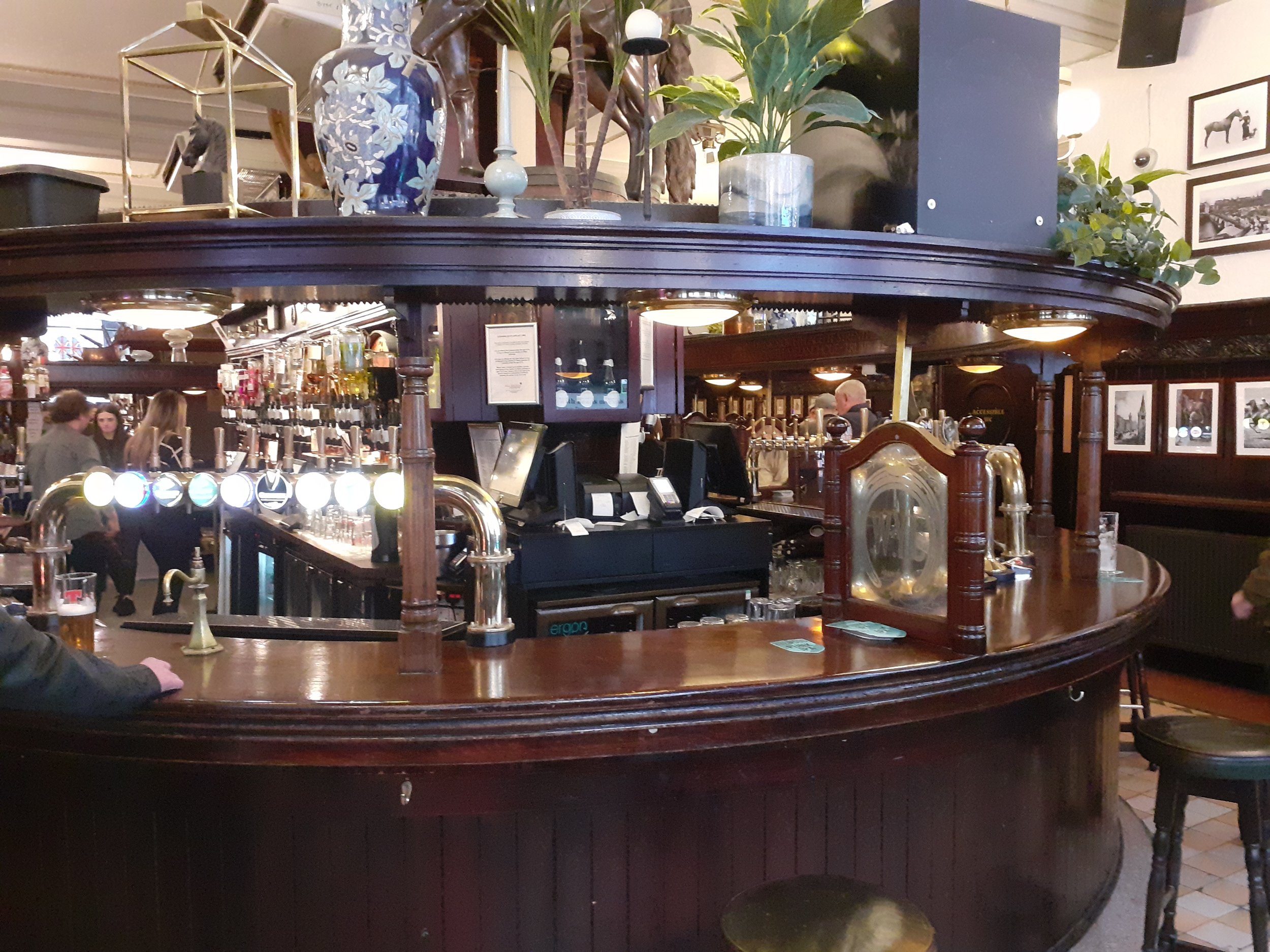
The Horseshoe Bar, Glasgow - longest counter in Britain at 104 feet. Partitions between small rooms and bar removed 1901

Sloans, Glasgow -

Cairns, Glasgow - island/oval bar
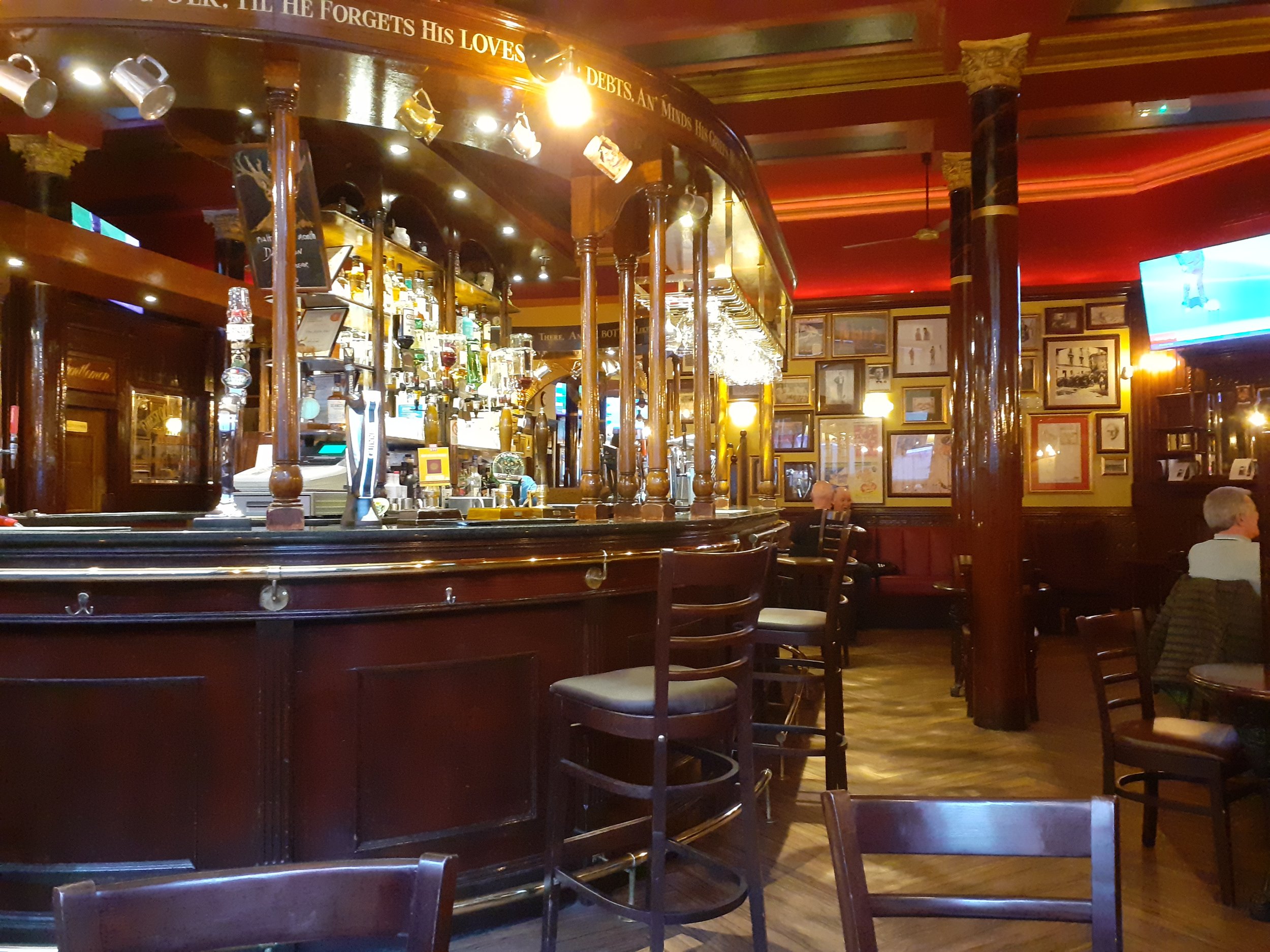
The State, Glasgow - island bar and lots of brass including counter to top of servery
Inside Scottish bars started to become very decorative. As redesigning to increase supervision and please magistrates opened up bars to be very roomy they also looked bare. To combat this lots of brass work appeared at the counters and large mirrors on the walls.
Whisky and beer had originally been poured from casks sitting behind the bar . These were supported on gantries, meaning a frame for holding barrels. Even when beer was pushed up from the cellar by water pressure the whisky casks still sat behind the bar. This area became called the gantry and in the spirit of brightening the bar up these gantries became very elaborate with mirrors and carved shelves and supports. Occasionally these carvings were erected on the bar counter itself. Always the wood and mirrors were highly polished and reflected light around the room. Especially useful in the many narrow yet long bars that existed.
While English pubs could have elaborate back bars they seldom ever had the spirit barrels.

Old Toll Bar, Glasgow - decorative mirrors

The Puffer, Dunoon - water tap for diluting whisky
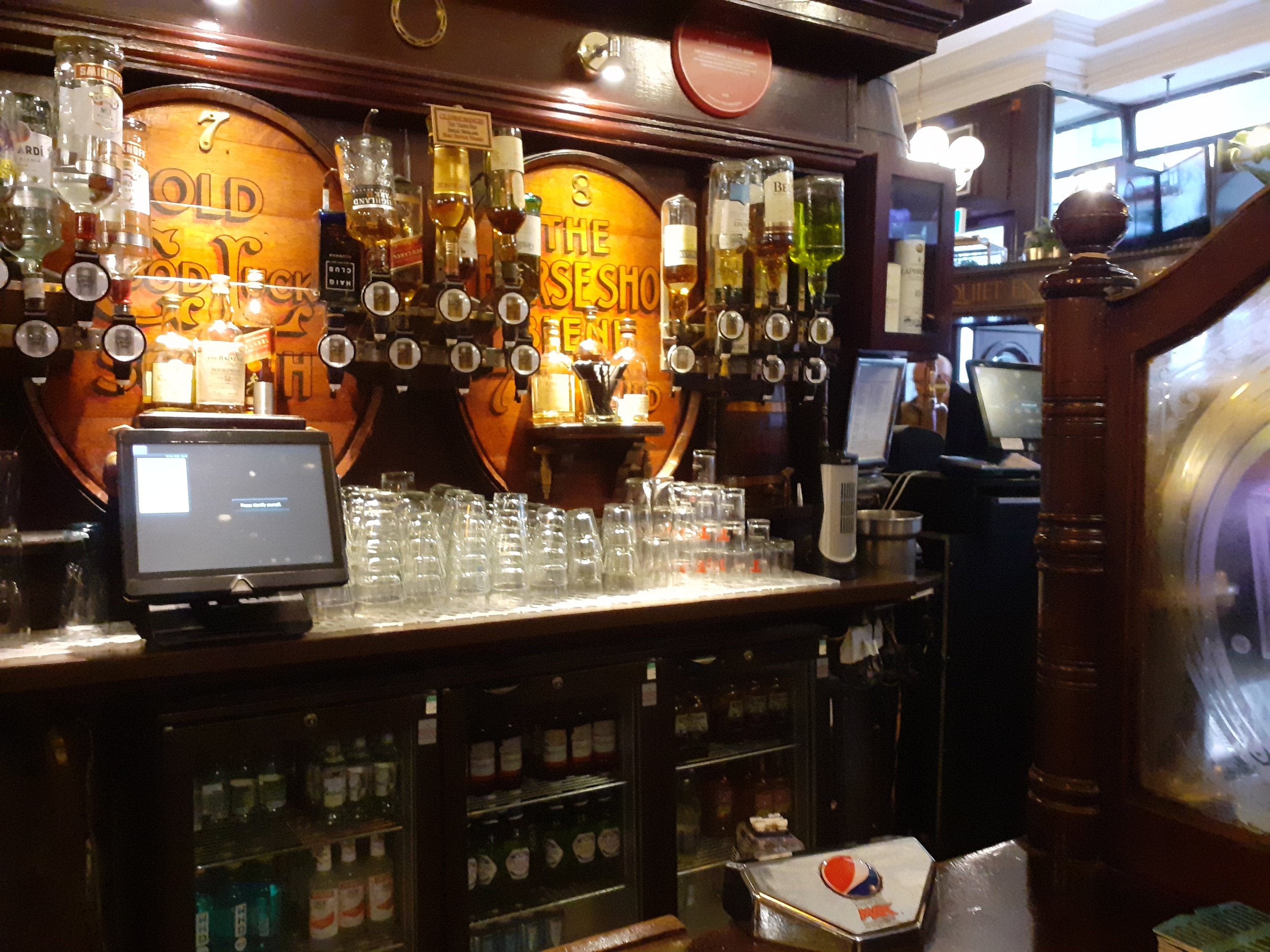
The Horseshoe, Glasgow - whisky casks on gantry
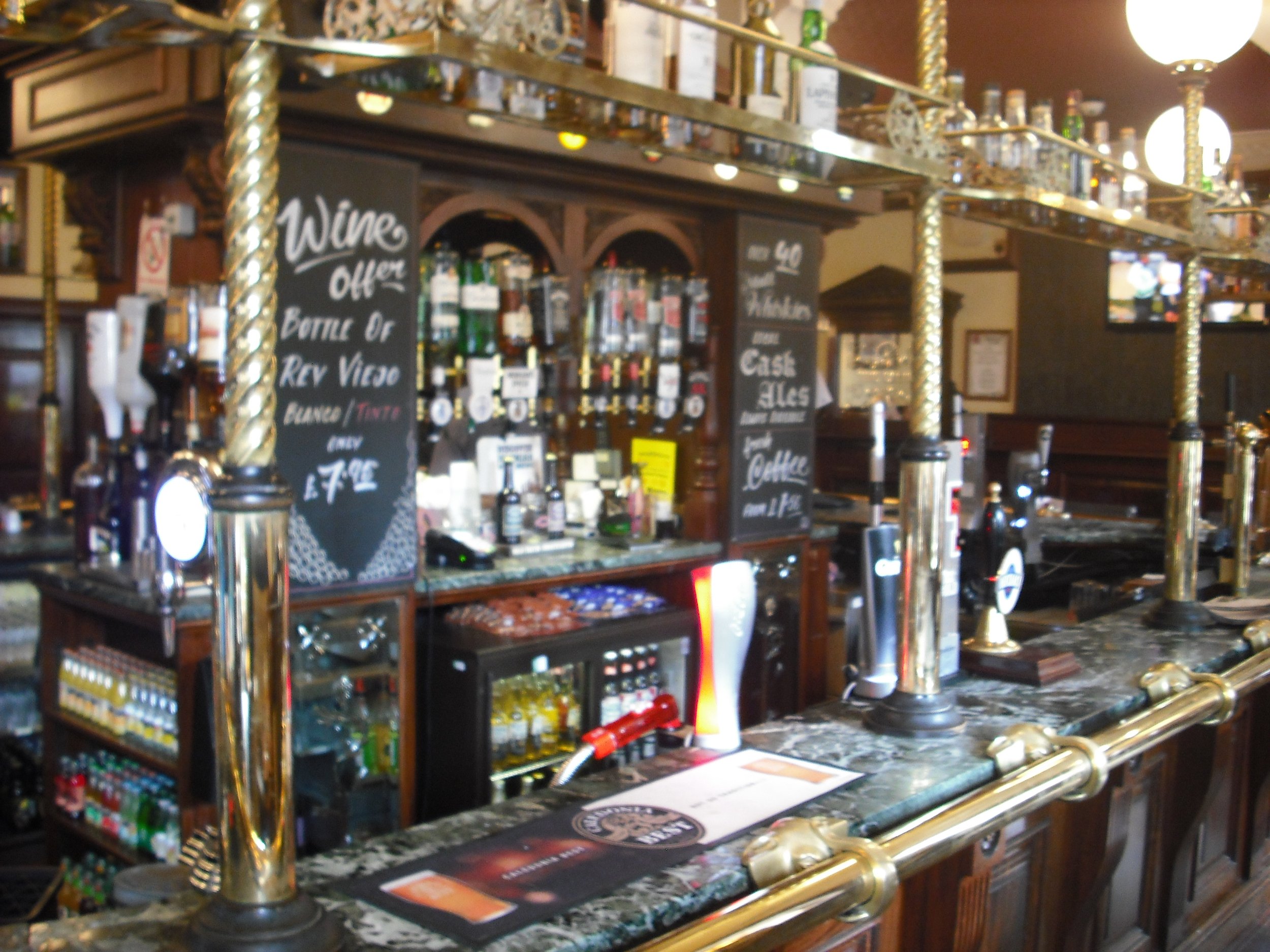
The Lorne, Oban - island bar with lots of brass including supporting a shelve above the counter
PUB QUIZ
What writer of detective novels also came up with the advertising phrase “Guinness is Good for You” ?
Answer at foot of page
Clubs
Clubs (needed rules and some form of membership) had come into existence some growing growing from illegal drinking places while others were formed by groups of peoples with common interests. These often started in from informal and formal meetings in Taverns etc and had grown in numbers after the Union. Cooke gives examples of Aristocratic Society for the Improvers of Knowledge of Agriculture (1923) , The Lawnmarket Club (Wool Traders) and The weaver’s Society of Anderston among hundreds that existed. Clubs were important organisations for allowing people with same interests to share knowledge, for many of the professional classes to meet socially and eventually to begin a movement of upper and middle class away from bars in the mid 1800s. Sports clubs also became popular and eventually some societies found their own premises.
Publicans did not like the existence of clubs as clubs had Sunday opening, no fixed opening hours, no licence duty, free from police supervision (as a private club) and could not be objected to by locals and nor did the proprietors have to convince authorities that they were of appropriate character.
The 1872 Licensing Act to curb drunkenness by making it illegal and stating that closing time was 10pm (London 11pm) covered only bars and not private members clubs. Of course the Tory government only meant rich upper class professional private clubs, however working men’s clubs and the many common interests clubs that existed could shelter under this Act as well.
Publicans did not like the existence of clubs as clubs had Sunday opening, no fixed opening hours, no licence duty, free from police supervision and could not be objected to by locals and nor did the proprietors have to convince authorities that they were of appropriate character.
The 1903 Act tried to deal with the club situation. Clubs had become very popular after 10pm on Saturday through to Monday to avoid Sunday closing. But now they had to be registered to sell alcohol and needed to supply their rules and regulations and a list of members. This supported the many legitimate clubs and drove others underground. The Act opened the way to making clubs more respectable, but numbers grew (in 1904 Glasgow had 49, then 60 the next year until 1908 when it was 71) and some continued to be gambling and drinking dens until caught. In Scotland registered clubs continued to enjoy pubs being closed on a Sunday until 1976 when Sunday opening for bars was finally granted.
Read Clubland by Pete Brown , a celebration of working men’s clubs in England.

Clubland by Pete Brown
4. The Tie
The tied trade never existed to the same extent in Scotland as in England. Most pubs in Scotland were free houses owned or rented by a single individual. Many of these “tied” themselves to breweries by loan or distribution deals although not necessarily exclusively.
In the 1970s it was not unusual to see beers from different breweries served in the same bar. Since Beer Orders and the advent of pubcos is not a surprise anymore to come across pubs offering a wide variety of beers, especially lager.
Nor is it a surprise to see some “tie” up of products for example a smaller minimalist bar may offer a choice of Tennent’s Lager, Caledonia Best and Magners Cider while slightly larger bar may add Menabrea and Heverlee to the line up. Some may push the boat out and add a beer from the Drygate Brewery. All of these beers are from the C & C stable with The Drygate Brewery being a collaboration of C & C and Williams Bros. (and of course Guinness in all bars)
In the 1960s and 70s Scottish and Newcastle was considered one of the big six brewery companies. This was formed in 1960 when Newcastle merged with McEwans/Youngers of Edinburgh to form a large brewing company with 1,100 pubs. Compared to the other big six (Allied, Courage, Watneys, Whitbread and Bass Charrington) this did not seem a lot of pubs, however, by this merger S & N now had extensive free trade in Scotland and the North of England making it a major seller of beer.
In England the majority of public houses had always been owned by breweries to exclusively sell their beers, however in the 1960s there were a lot of mergers/takeovers such that between 1955 and 1968 two hundred breweries were taken over. Brewers were certainly not trying to buy better beers to sell. Lots of breweries were bought over with promises to keep brewing their beers but many were soon closed for economic reasons.
The Monopolies Commission’s report on the supply of beer in Britain published in April 1969 recommended that the supply of beer should be opened up and that the tied house system operated against the public interest. At this time 86% of English pubs were owned by a brewery (78% by one of the ‘big six’) while it was only 27% in Scotland. The majority of bars in Scotland were owned by single individuals. Although there already were the start of pubcos as some businesses owned a group of pubs.
Number of pubs owned by big six brewers
year year
brewer 1960 new brewer 1972
Inde Coope 2,500 Allied 8,000
Charrington 2,400 Bass Charrington 9,300
Courage 3,500 Courage 6,000
Scottish & Newcastle 1,700 Scottish & Newcastle 1,700
Watneys 4,000 Watneys 6,000
Whitbread 2,500 Whitbread 8,500
from Death of the English Pub by Christopher Hutt (1973)
Derek Cooper in The Beverage Report (1970) describes Birmingham as having 815 pubs of which 729 (89.4%) were owned by two of the big six beer companies; Bass with Mitchell & Butlers (M & B) and Allied Breweries with Ansells. The remaining 86 pubs and 400 clubs in the area would have been mainly supplied by these two. M & B pubs had Brew XI , M & B Mild and Worthington E as its special keg bitter. Ansells had a similar range Bitter, Ansells Mild and Double Diamond as its special keg Bitter. Both Double Diamond and Worthington E had been around as bottled beers before becoming keg.
In Scotland even without a “tie” by 1992 S & N had a 45% share of the market and Tennent Caledonian (Bass) had 40%, Tetley /Carlsberg (allied) had 9% .
Belhaven Brewery shows how Scottish brewers used tied and free trade as their market: Belhaven with only 62 bars and sold 18% of beer to those 62 tied bars and 82% to free trade.(1)

The Three Reasons, Largs - a free house
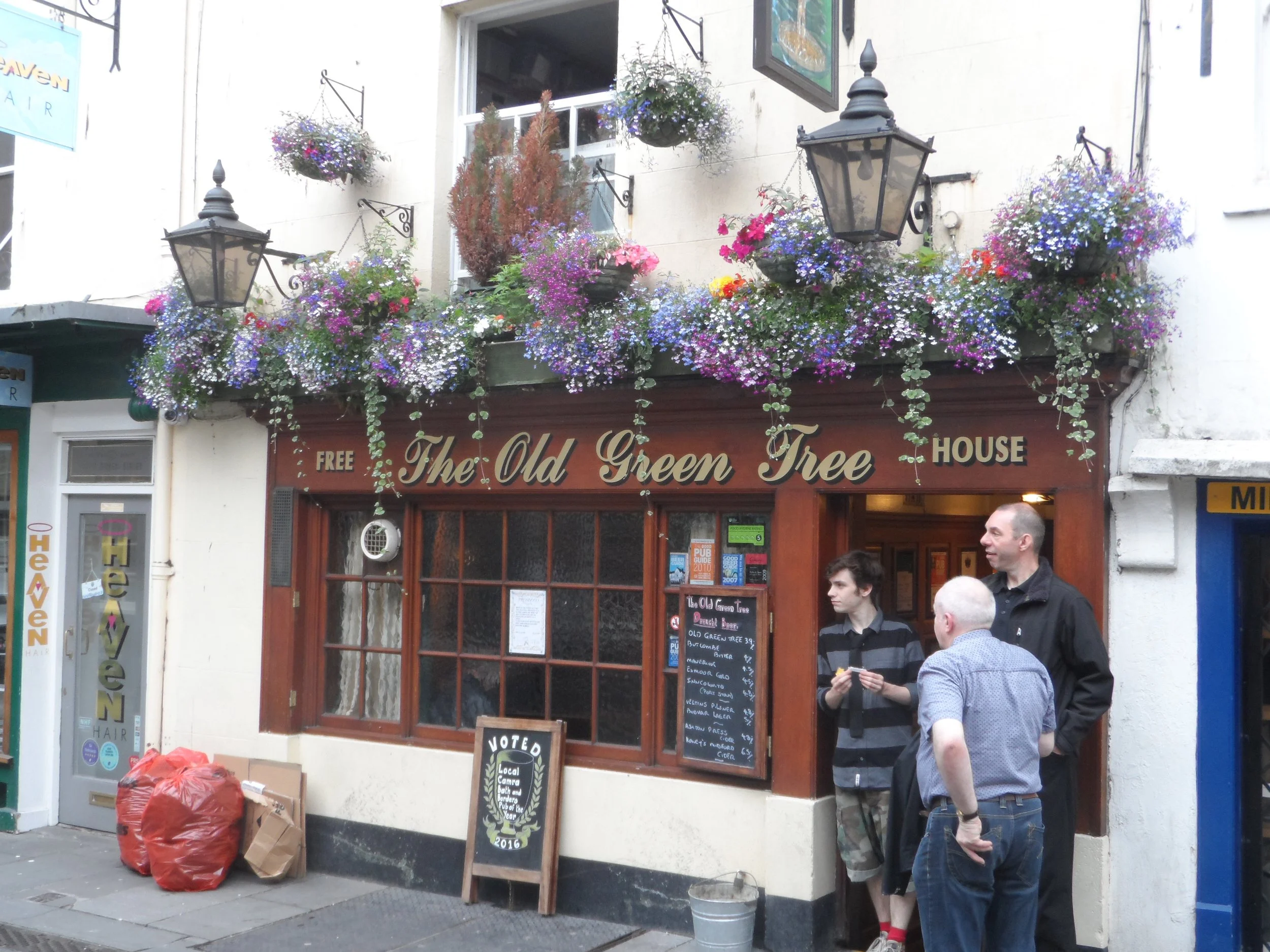
The Old Green Tree, Bath - unusually a free house in England

Committee Room No 9, Glasgow - no tie
5. Naming Beers
Beers in Scotland were not known as Bitter and Mild but the rough equivalents were Heavy and Light. The special bitters in England would be termed Export or 80/- while the growing influence of Lager had the same name in both countries. In 1960-70s there was not the range of beer styles we have today. There may have been lots of beers brewed in the 1950-60s but most breweries produced their version of a limited number of styles – bitter, mild, a special bitter etc. The numbers of actual beers brewed started to reduce as takeover after takeover reduced the number of breweries, For breweries this was more a rush for outlets to sell their beer as much as buying off competition
From the “big six” came a local mild and a bitter from some large local brewery which they owned. In Birmingham Bass Charrington had local brewers Mitchel & Butlers ( taken over by Bass in 1960) selling Brew XI and M&B Mild while Allied Breweries (formed in 1962 when Ind Coope, Ansells and Tetley merged) had local Brewer Ansells, selling Ansells bitter and Ansells Mild.
Each of the big six had one or more keg brand that they promoted nationally; Allied was Double Diamond (3.5%) or Tetleys, Bass Charrington was Worthington E (4.2%), Whitbread had Tankard (3.9%), while Watney’s was Red (3.4%), Courage had Tavern (3.8%) and S & N had Tartan Special (3.9%). So, in Birmingham they were Double Diamond and Worthington E. In The Lager stakes, Bass Charrington offered Carling Black Label while the Ansell’s pubs had Skol.
Thus, there were limited styles of beer available in both Scotland and England. Though in 1963 with 1% market share (and 19% of advertising budget) Lager was on the way to becoming an important new style of beer for brewers and drinkers in Britain. By 1968 lager had risen to 20% of beer sales in Scotland about half of that in England.
In Scotland a traditional naming of beer was based on beer duty from the 19th Century which existed in tandem with Heavy and Light. The beer duty had been given in shillings, (pre decimal money) with the stronger beer paying more duty. During the 20th century many values of beer duty shillings were brewed. Some beers were named after the duty eg Morrison’s 90/- (called 90 shilling) India Pale Ale.
The ”shillings” labels stuck for some beers and marketing reasons at 60/- (sixty shillings, where /- was the unit for shilling before decimalisation), 70/-, 80/- and 90/-. The shilling name no longer having a relationship with actual beer duty. In fact, as 80/- was equal to £4 (20/- = £1) and this the duty value is now less than the cost of a pint.
60/- was the equivalent of Light beer. That is beers with an abv of around 3.5% could be labelled either as 60/- or Light, or even both. This would be the Scottish equivalent of mild.
70/- or Heavy (from the runnings that the beer was made from - see ‘Taste’ below) could be looked on as being the bitter with an abv of around 4%.
Export or 80/- (abv 4-5.5%) was perhaps a special bitter. The equivalences of these ranges to English names is very rough as there were distinct differences in the taste in Scottish beers. The beers being maltier and sweeter, and darker in colour.
A final ale was over 6% abv and called a Wee Heavy or a 90/- ale which could be said to match with a Barley Wine.

The Cellar Bar, Oban - with McEwan's 70/-

The Scotia Bar, Glasgow - with Belhaven 80/-

The Laurieston Bar, Glasgow
6. Dispensing Cask
Draught beer came in wooden barrels and for centuries had been served straight from the barrel but by 1880s Scottish pubs used air and water pressure. A small engine converted mains water pressure to air pressure and this pushed the beer from cellar to counter. The bar staff turned a tap on top of a tall faunt (font) to allow the beer to flow into the glass.
In the 1950s water pressure was being replaced by electric compressors supplying the pressure. The faunts involved could be quite tall and fancy. The English hand pump, which is now common in Scotland’s real ale pubs, is based on a suction process.
Although the pressure pump could raise the beer a greater height than the handpump found in English pubs it never became popular in England, possible because English casks could not withstand the pressure and would leak.(2)
Keg beer and keg lager, even more so than in England, made inroads in the 1960s. By 1976 Licensed to Sell (by Brandwood, Davidson & Slaughter) states that the Scottish Real Beer Guide showed only 207 outlets with 161 using electric compressors, 9 hand pumps and the rest water pressure compression.
As real ale made a reappearance Scottish bars began to use handpumps rather than compressors as the handpump clearly showed the existence of cask without the confusing of fancy faunts of keg with compression dispensing taps. By 1984 The Real Ale in Scotland book recorded 470 pubs with handpumps, with 212 using air pressure and 228 electric pumps.
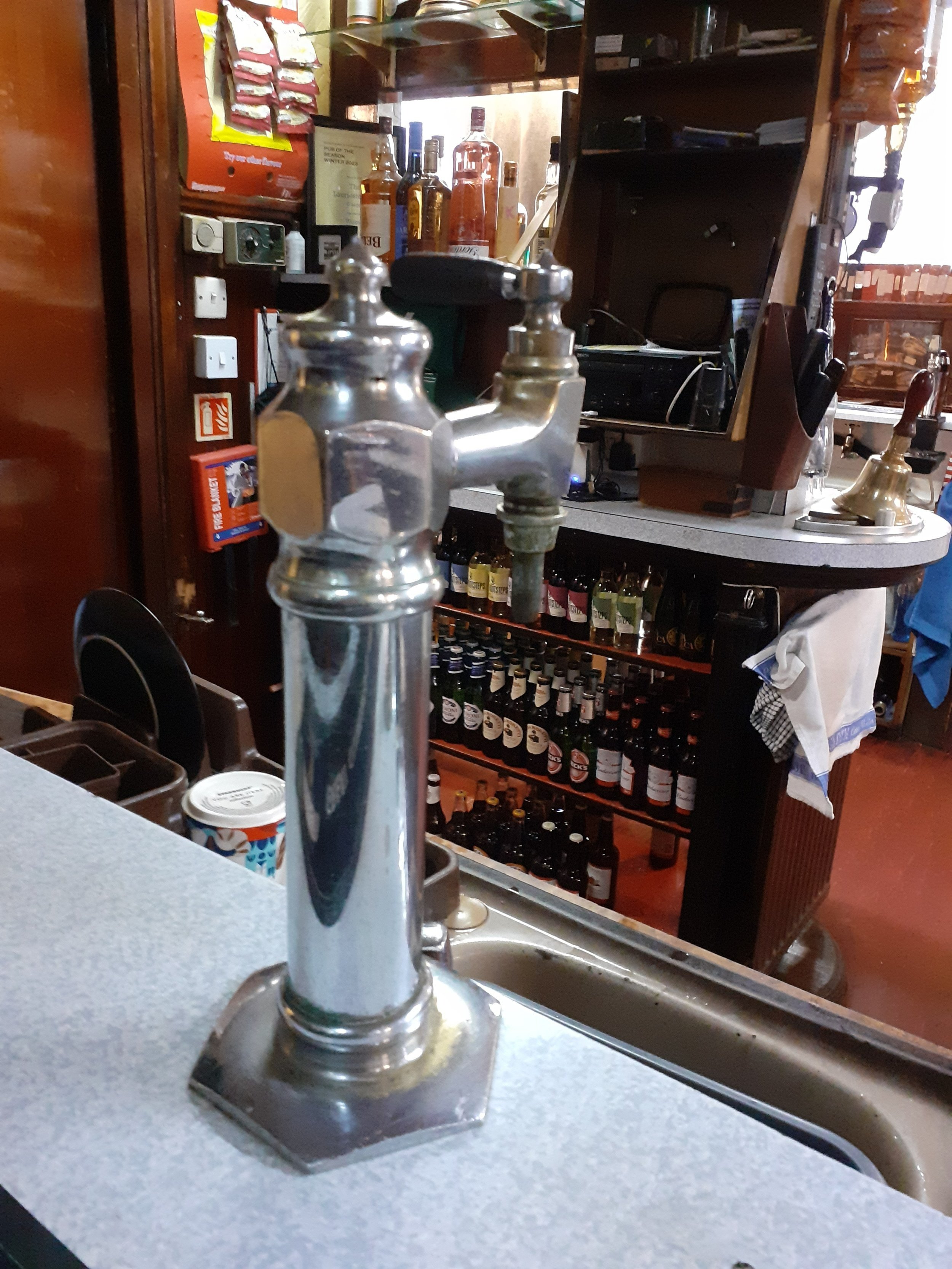
Lauriston Bar, Glasgow - water pressure founts for dispensing beer - originally in The Rising Sun

The Viceroy, Glasgow - water pressure founts for dispensing beer c19th Century

The Viceroy, Glasgow - water pressure founts for dispensing beer c1950s
Returning spillage to cask was a shock to me. I was disturbed enough by attempting to put spillage in pints when I worked in Scotland but going back in the barrel was a step further. The Junction was a Mitchell & Butlers pub as had been The Junction Hotel which was in the position before 1903. The main draught beers were Brew IX and M & B Mild. The special beer was Worthington E and Carling was the lager. It was not that the pub was a real ale promoting pub, it was just that, like most pubs in the area, cask had never been removed.
The Junction had a good name for Mild. Our Bitter spillage would, above a certain volume in the barrel, be returned to the bitter and similarly the mild to the mild. Whereas The White Horse had a good name for bitter as it did not return anything to the bitter, though it emptied bitter and mild spillage the mild.
From 1963 https://www.theguardian.com/theguardian/2014/feb/12/beer-pubs-slops-hygiene and from 2011 http://tandlemanbeerblog.blogspot.com/2011/01/filtering-back.html
You do hear of the early 70s of places being real ale desert. This was questionable in Birmingham. Real ale was still being sold in almost all of the pubs in the area where I lived , however the desert part would describe the lack of choice. Basically we had Brew XI or Ansells Bitter. However, compared to Norwich a city that claims a pub for everyday of the year, real ale in 1967 seemed to be limited to The Wild Man.(Tolly Cobbold) in the city.

The Wild Man, Norwich - kept real ale alive in Norwich
Dispensing spirits
In 1971 spirits of rum, whisky, vodka and gin could be sold in a quarter, a fifth, or a sixth of a gill (ie 36, 28 or 24 ml). In Scotland the usual measure was a fifth of a gill while in England it was a sixth. Occasionally, especially in clubs, a quarter of a gill was served in Scotland. Strangely this was not formalised until the 1963 Weights and Measures act.
I worked in a holiday camp in Scotland whose headquarters was in England therefore we sold spirits in sixth of a gill. This gave rise to many complaints from Scots who holidayed there.
In the pub I worked in in Birmingham, if ever a description was ever true this was “an old man’s pub” and we went through at most a couple of bottles of whisky a week. In an area which had students - they didn’t visit us.
7. Taste and drinking habits
By the late 19th Century of the 34,456,345 barrels of beer in Britain only 5.7 % were brewed in Scotland (PP). Much of the beer produced was exported to many countries with most to the British East Indies.
The Oxford Dictionary of Beer suggests that “Traditionally, Scottish ales of different strengths were brewed by the parti-gyle method, whereby the strong ales were collected just from the first runnings of the mash and boiled and fermented separately. These “heavies” may have had an alcohol by volume content of 9-10%.
The second runnings would become one of the weaker ales yielding an Abv of 3.5%. A possible third running produced low alcohol brews referred to as “two-penny -ales”
“ Fermentation carried out in ambient temperatures of cold Scotland and as a result levels of fruit esters tend to be low. For the same reason, stronger Scotch ales have traditionally had more residual sugar .”
At the time of the Union Scottish beers would probably have been more malted than English beers as The Malt Tax on English beer was not passed on to Scottish brewers when the parliaments joined, in fact, not until 1713, and even then not widely enforced until a new Malt Tax of 1725 . This caused riots in Edinburgh and Glasgow. However, the Scottish brewers had had 18 years of not paying a malt tax which had made their beer much cheaper and drinkers would have a taste for it now. The arrival of excisemen after the Union was shock to Scottish brewers.
The Dictionary suggest that Scottish beers have never been particularly well hopped (as hops do not grow in Scotland")” so beers tend to be less hoppy. Yet there is evidence that Edinburgh beer did use a similar quantity of hops as in English beers Youngers of Edinburgh were buying hops from Sussex, Suffolk, East Kent and Worcester in 1856 ( Good Company: The Story of Scottish & Newcastle by Berry Ritchie). Younger’s beers had some popularity in London as 20% of the production passed through London for export and a good proportion was being drunk there. Though the use of the milder Worcester hops again suggests Scottish beer being less hopped.
Edinburgh , having similar water to Burton-on-Trent meant that India Pale Ale was increasingly produced in Edinburgh. Weaker beers became more popular in Scotland (for the brewer weaker beer meant less duty and quicker turn around time) eventually opening up Scotland’s taste buds to the lager trade.
The 2020 Good Beer Guide when charting beer styles has sweet beers matched with malty and describing the style as’ “traditional Scottish beers”.
LAGER
Lager was being imported into Scotland in the 1870s and as sales grew J & R Tennent started to brew lager in 1888 and opened a special lager brewery in 1906. John Jeffrey in Edinburgh brewed lager from 1906.
Pete Brown (Man Walks Into A Pub) reckons Scottish beer was already more like lager than English beer as being, “less hops, less, bitter, lighter without the frothy head associated with English bitter”.
None of which explains why a cold drink became so popular in a cold climate?
By 1971 Lager had always sold better in Scotland than in England; 20% of beer sales in Scotland in 1971 compared to 10% in England.
This was well before 1973 when Terry Lovelock came up with the advert for Heineken Lager as “The beer that refreshes the Parts other beers cannot reach” this advert that is given credit for forging ahead lager sales.
In 1963 lager had 2% of the market. Heineken and Carlsberg were trying to sell their lager in Britain but not gaining much interest (even with lime added). But by 1971 lager had nearly 10% of beer sales, though this was 20% in Scotland, where Tennent’s Lager was the big seller. In the mid-seventies Heineken became the best known lager in the country, though at lower strength than in Europe, following a successful ad campaign “Heineken refreshes the parts that other beers do not reach” (campaign background) (advert).
By 1976 lager sales were 25% (40% in Scotland ). By 1979 lager was 29% of sales, 43% in 1986 and finally over 50% in 1990.
Today Tennent’s Lager has 60% of Scotland’s lager market, followed by Peroni, Carling and Stella.
In fact lager has a substantial part of the Scottish beer market and it is common in bars that do not serve real ale to have only one heavy/bitter on offer and several lagers. Two extremes are The Toby Jug with Caledonian Best for Heavy/Bitter and near-by Stereo with no keg heavy/bitter

The Toby Jug, Glasgow - lagers are Angelo Poretti; Kelvin (Drygate);; Tennent’s; Carlsberg; Stella; Estrella ; San Miguel Special; Heverlee; Carling; Tuberg; Erdinger
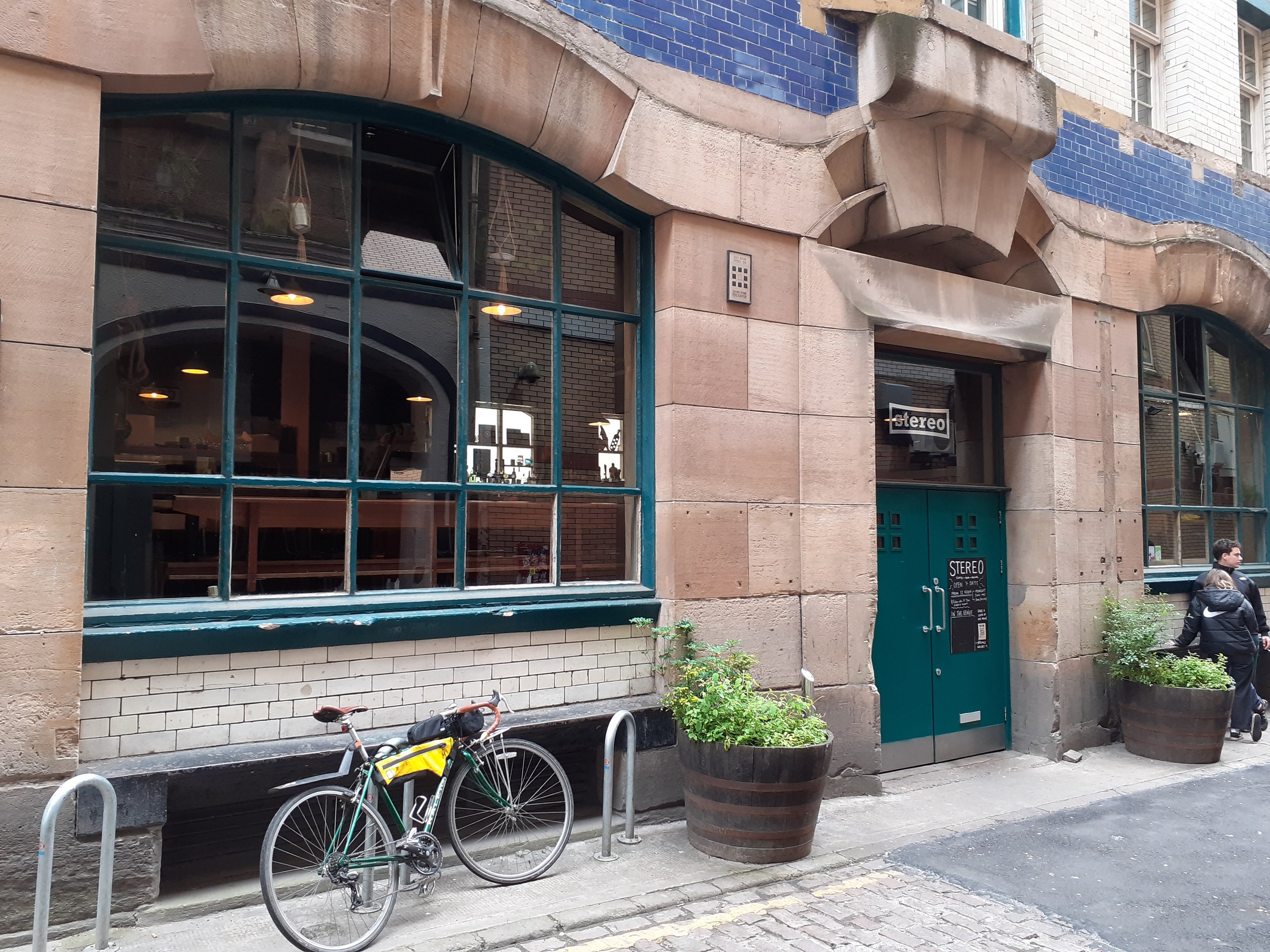
Stereo, Glasgow - lagers are McEwan's; Estrella; Birra Moretti; Afflinghem; Heineken; Fosters; Amstel; Krusovice
Different habits
When first working at The Junction in Birmingham as a barman I was asked for a “half and half” and so produce a whisky and half pint beer much to my customer’s shock as he had wanted a pint of half bitter and half mild.
The manager made sure that staff were drinking behind the bar. If nobody had bought you a half pint you had to pour yourself one and keep it topped up. The reason for this was that if the staff were not drinking the beer why should a customer? The one thing we were never to do was to hold a glass up to the light to see if it was cloudy. This was because half the pub would rush to the bar to say their beer was cloudy as well and could it be replaced even if they had drank three-quarters of it. This could not happen in Scotland because drinking behind the bar was not allowed.
I noticed that when buying a new round in Scotland it was signified by someone finishing their drink. Somebody without drink meant more had to be bought. While in England a new round was not bought until most had finished their pint. This may have been affected by drinkers in England handing back a pint glass to be refilled while in Scotland it was illegal to use the same glass. All had to be washed. Again, a subtle, and generalisation, difference in drinking habits. There was however, still a rush for that final one or two drinks.
Both countries have many people who do not make full use of their taste senses as they are devoted to very cold beer and drinking out of bottles.
8. Open Air Drinking
Outdoor drinking had not been a normal event in Scotland.
Even after extension of opening hours in 1976 and even where these had been to accommodate tourists the authorities and religious/anti-drink campaigners etc still held back allowing sitting outside drinking to be allowed. Seating along the pavement would be frowned upon because of its corrupting influence. Part of the problem was that the bars had never been built to accommodate outside seating.
Because Scottish bars were constructed as housing in tenements when built these bars were missing gardens at front and/or rear so outside seating could only be along pavements. This also meant that pubs with large carparks as found in England did not exist in Scottish towns and cities.
Rose Tavern, a corner pub in Norwich flanked by terraced housing and the landlord and family live above the pub. It has room for seating out front and a large rear garden.
The Doublet, a corner bar in Glasgow, is the lowest floor of a tenement building with flats above it. There is only room outside by taking up the pavement space seating. At the rear there are drying greens associated with each flat.

The Red Lion, Handbridge Chester - outside seating at front - seldom room for this in Scotland

Rose Tavern, Norwich - large back beer garden

The Red Lion, Stockton Heath with a bowling green - not seen in Scotland in a pub. No games policy was modified to allow darts and Dominoes. Plenty of Bowling Clubs.
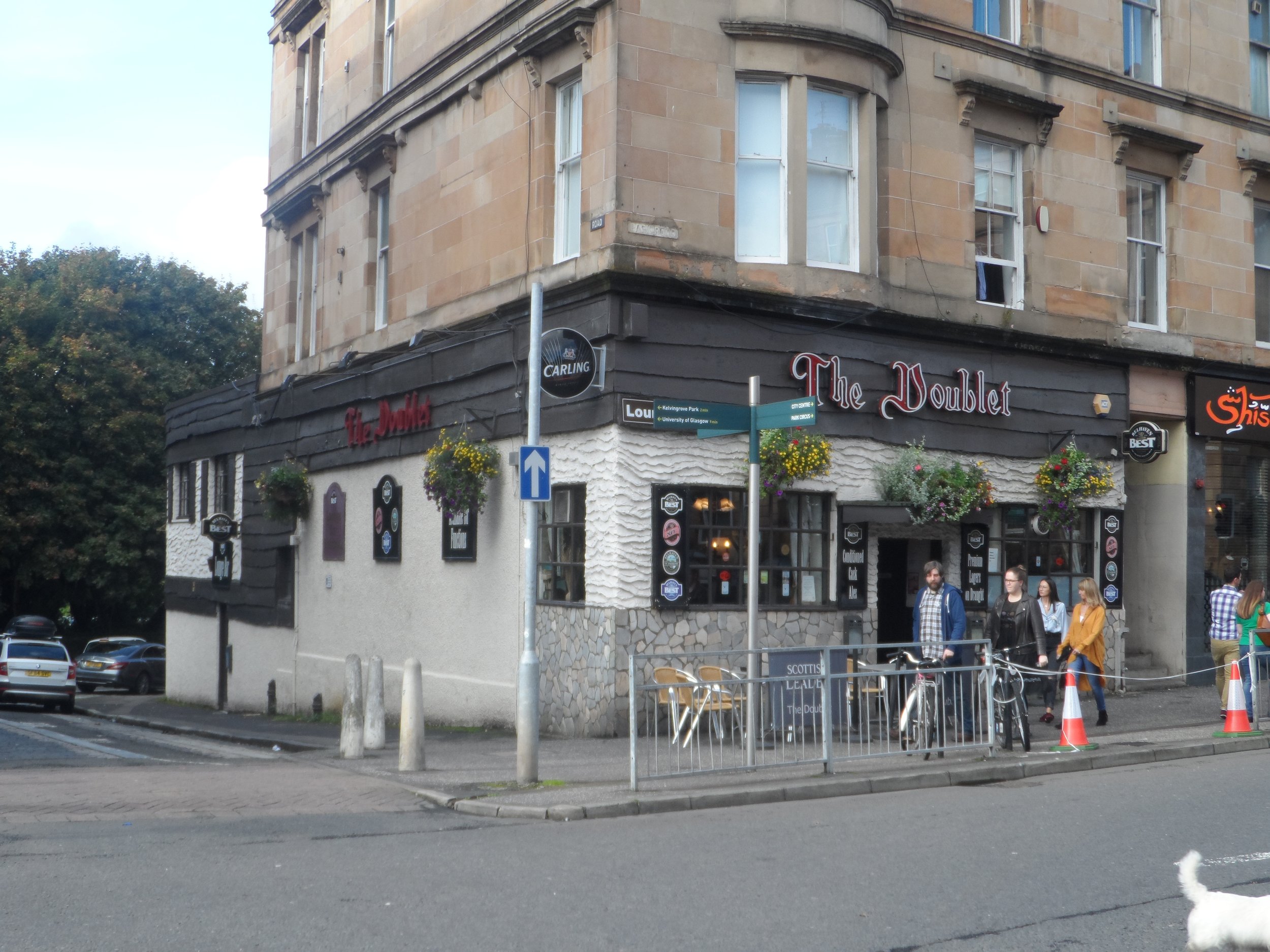
The Doublet, Glasgow - trying hard to get some tables on the pavement

The Unthank Arms, Norwich - seating outside but not on pavement and surrounded by terraced houses.

Red Lion, Stratford upon Avon - beer garden. Not in Scottish City pubs
Suddenly “beer gardens” were advertised in bars some of which were little more than small slabbed standing areas without even a plant pot as an ashtray.
Many beer gardens, in both countries, lack grass and plants, and even though they don’t grow pints of beer are still labelled ‘beer gardens
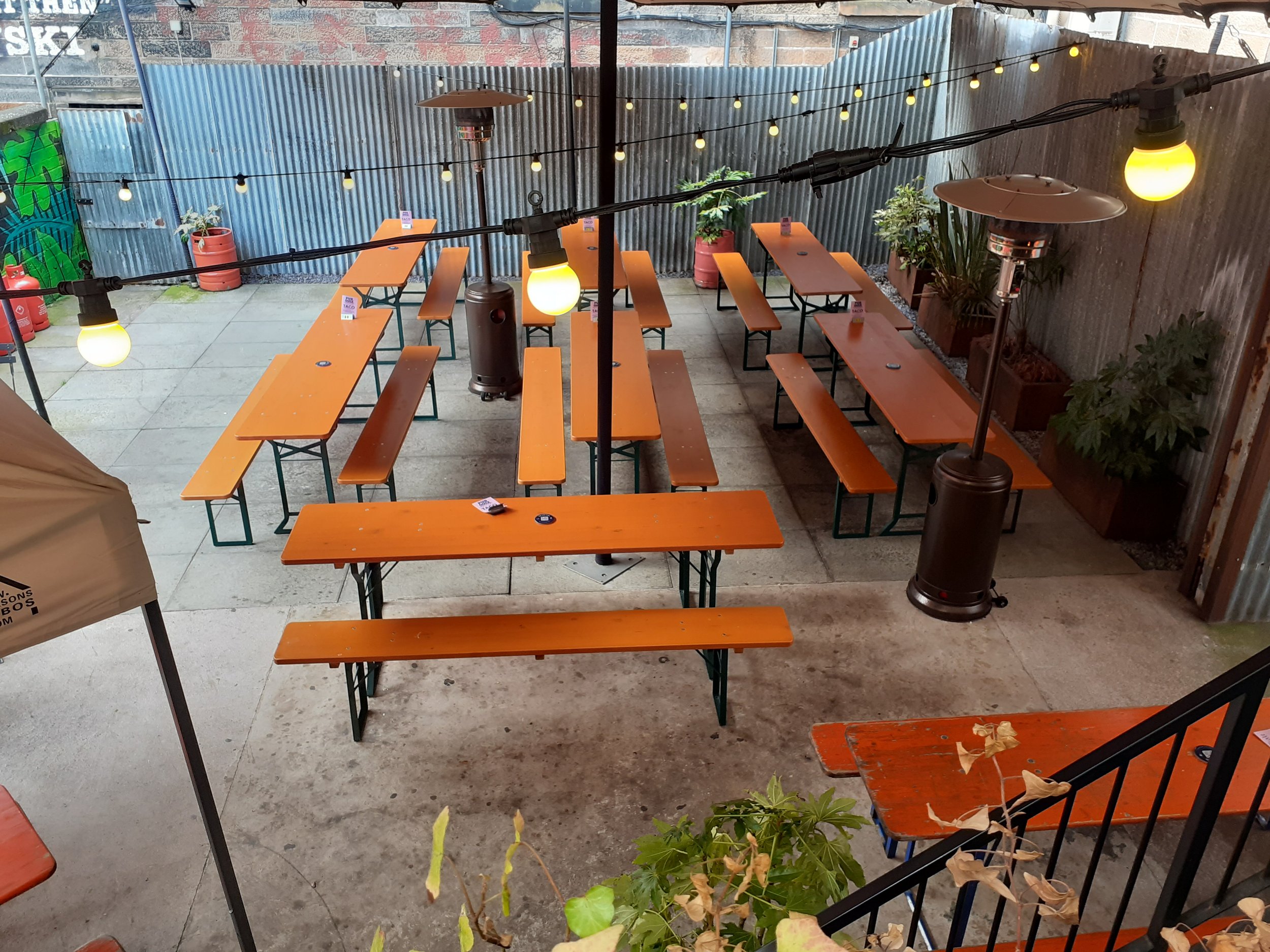
The Locale, Glasgow -outside seating in back yard with some plants to make a "garden"

Ye Olde Royal Oak, Knaresborough

The Golden Rule, Ambleside
The more touristy a place was the more likely that at some point outside seating had been allowed. The problem would be finding a piece of pavement to put some tables on. As years wound on a fortunate few bars in cities found that the road outside had been pedestrianised so they could layout tables and chairs.

The Amsterdam, Glasgow - outside at a pedestrian precinct

The Counting House, Glasgow

The Pavement - aptly named now has seating in pedestrian area
Some had basement entrances where tables could go.

The Big Slope, Glasgow - outside basement of tenement

Buck's Bar, Bath St, Glasgow - some barrels as tables at a basement entrance
8. Open Air Drinking con’t
When Greenock hosted the Tall Ships Race in 2000 it was the first time that on pavement seating was allowed outside of the pubs in the area. This stopped after the ships had left. Tourists could behave and not corrupt others but not locals; remember a lot of these tourists were from other places in Scotland.
The covid pandemic and restrictions on drinking, and it is easy to believe that many organisations, health officials and politicians were pleased to see the closure of bars brought more drinking in outside spaces. Once bars reopened but maintaining distance brought further search for outside spaces and the granting of their use. The Cardwell Inn in Gourock shows the outside before and after the pandemic with the after still being allowed.
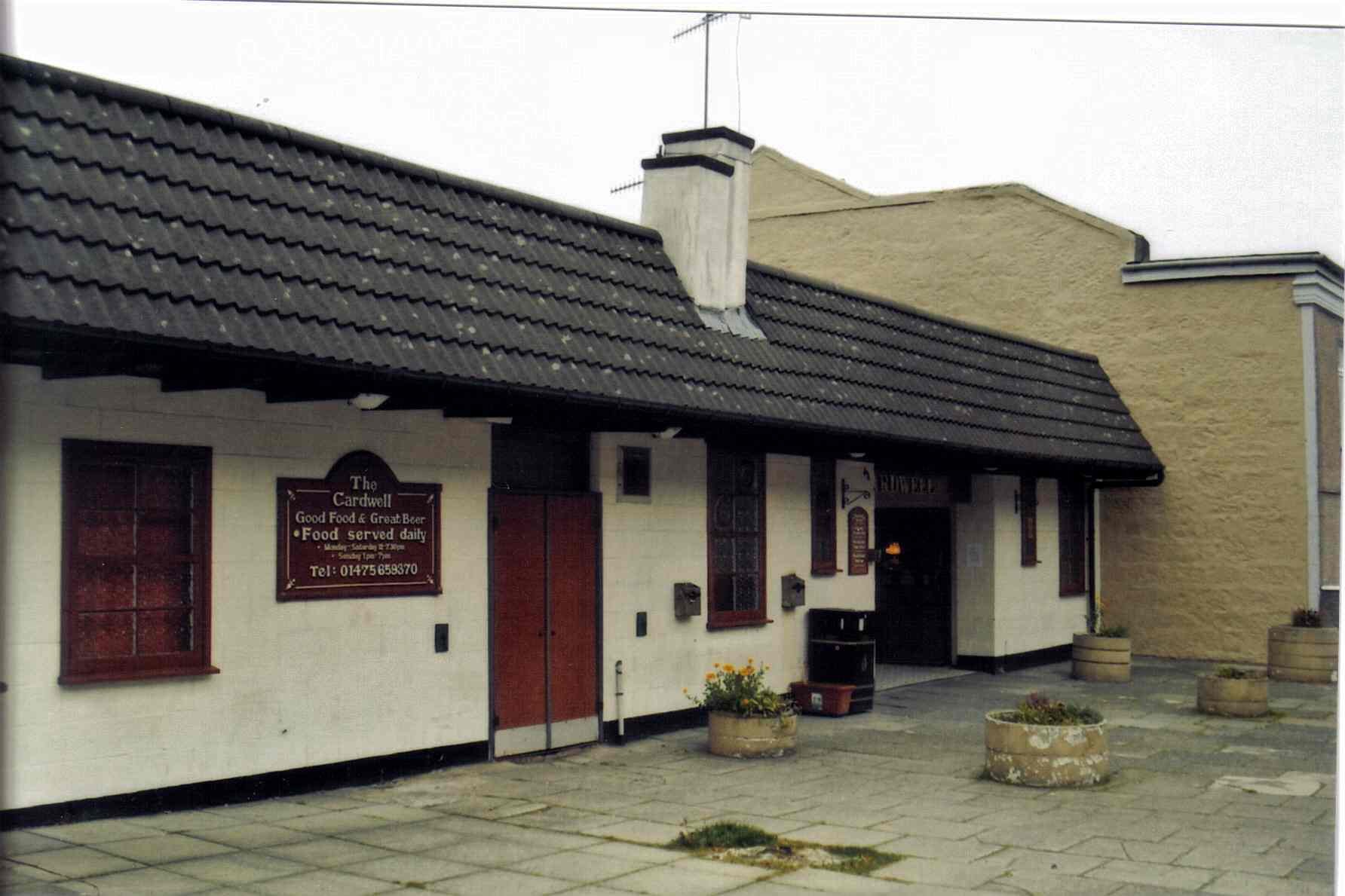
Cardwell Inn, Gourock - pre-pandemic
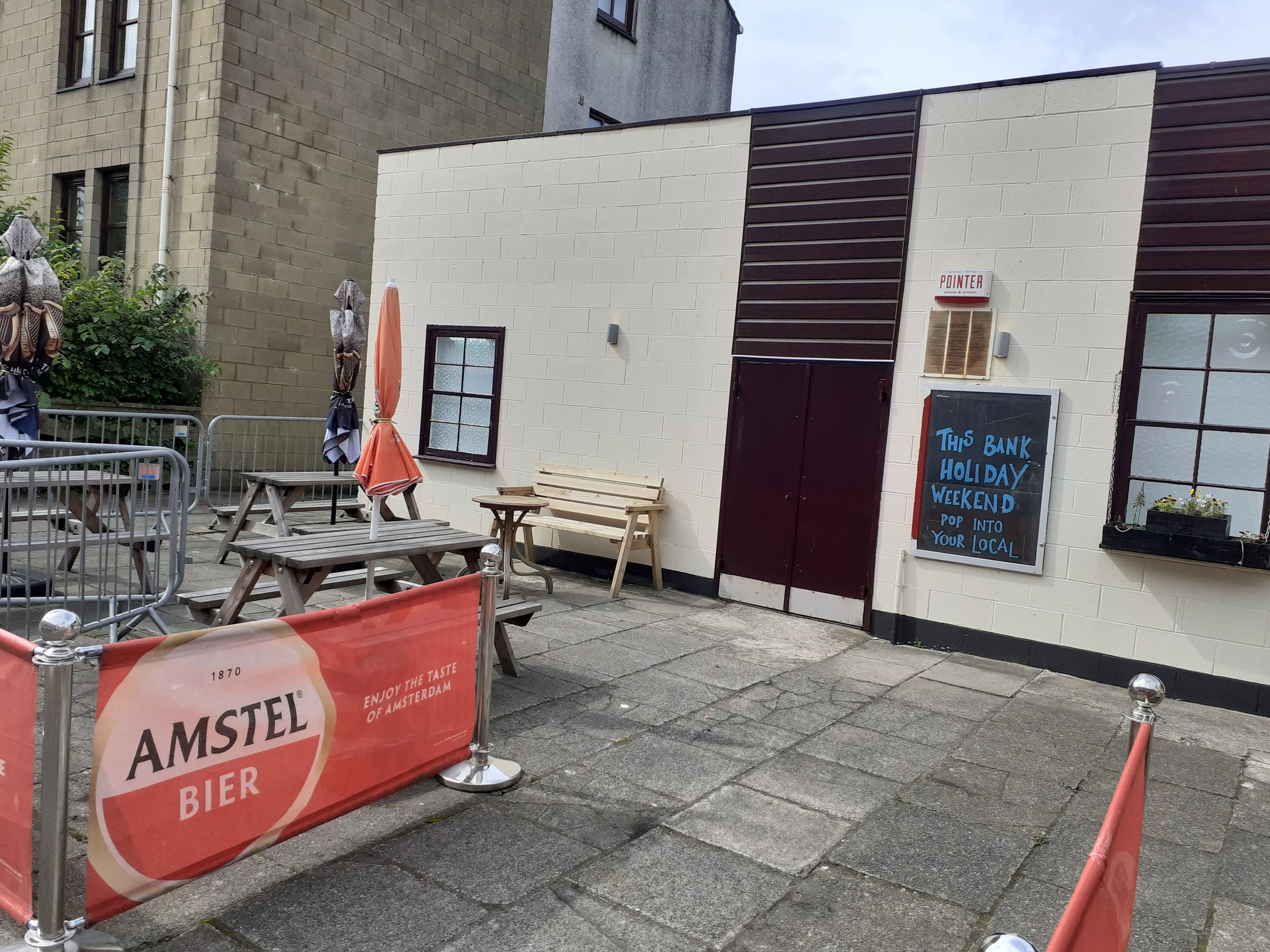
Cardwell Inn, Gourock -pandemic and after
9. Smoking Ban
The Smoking Ban in public places in Scotland, which included bars came in on 26th March 2006.
England & Wales caught up with Scotland over a year later on the 1st of July 2007.
How quick we got use to the ban on smoking in pubs is shown by being on holiday in Hunstanton in August of 2006 we were indignant to see someone breaking the law by smoking in the hotel bar. Of course they were not breaking any English law at the time.
Bars had survived without an outdoor space; after all it was Scotland and they had not existed before. Then the introduction of the smoking ban in 26th March 2006 caused a search for spaces at the back of the bar where smokers could go rather than stand by the front door. Though for many the front door was all that was available.




The Thistle, Inverness - not everyone was happy
10. Route towards longer hours - more detail in “History” section
a) Clayson & Erroll Committees
In 1971 two committees were set up by the then Conservative Government to look into licensing laws in Britain. The Erroll Committee for England and Wales and The Clayson committee for Scotland. The Clayson committee reported in 1974 by which time Labour were in Government and the report was for the teetotal, Secretary of State for Scotland, Willie Ross. The recommendations were not popular with the Government of Harold Wilson. While some of the changes recommended for Scotland were introduced in 1976 the recommendations for England were not introduced until 1988. Thus, Scotland suddenly had less restrictive licensing laws than England. Clayson produced many recommendations but those that would affect the public directly and thus drinking habits rather than changes to how licenses were granted were: extension of night-time closing time, Sunday opening for pubs, allowing children to accompany adults into pubs and opening from 11am to 11pm.
b) Little changes
In 1975 Willie Ross (Secretary of State for Scotland) announced that the Government planned to implement only parts of the report. He accepted the increase in hours to 11pm in the evening for pubs and hotels but not any other changes to drinking time.
Thus, of the major recommendations, Refreshment house license, Children’s licence, Sunday opening, opening until 11pm and afternoon opening Mr Ross was only accepting the extended evening hours and Refreshment House licence. This was then passed to The Scottish Standing Committee to finalise.
c) Government loses
However, against Government wishes, the decision was taken by the Scottish Standing Committee that Sunday opening was to be allowed. This happened 10 votes to 4 with three Labour MPs rebelling.
Thus, Committee had added Sunday opening but not all day opening, and The Lords agreed with this.
Therefore, in October 1976 The Lords accepted the extra hour and Sunday opening and by December 1976 pubs could close at 11pm.
d) Behaviour changes positive
By July 1977 Government reported that comparing before and after the addition of the extra hour the number of drink and driving cases has dropped by 20 per cent. People were taking a more relaxed approach to drink. In the first three months of 1977 25 million gallons of beer were consumed. Exactly the same as the amount as in the first three months of 1976.
e) Sunday opening
This took a year longer to come in. The new Licencing Boards were not set up until July 1st 1977 and the first meeting at which a Sunday Licence could be applied for was October. The first pub to get one was The Cowie Tavern in Stirlingshire.
f) So how did “all day” come about?
Section 64 of the Act made allowances for occasional and regular extensions of permitted opening hours and para 3 which covered the reasons for allowing extended opening could be interpreted very liberally as it mentioned “social circumstances” and “activities taking place locally” so could be widely applied and began to be so.
Serving tourists was an obvious use of regular extensions and seemed to cause no issues although many areas added the need to stop the extension in September. Obviously, nobody expected tourists after this! Then serving businessmen who had a wide range of lunch hours, then only a step to shift workers, and in cities what about shoppers needing refreshment? Once one pub got an extension nearby pubs could use it as leverage.
In Glasgow Peter Keenan got the first 11am to 11pm license for Thursday, Friday and Saturday. The nearby Off The Record Bar could see no reason why they could not get one as they catered for the same clientele. Then slowly but surely more and more 2.30 to 5pm extensions were given.
g) Not all happy
Not everyone was happy with these extensions and there were many inconsistencies. Scottish Office did not provide any clarity in interpretation as they passed it back to local licensing authorities.
The police accepted that local markets and tourism were clear reasons for extensions but at the same time objected to every application. Not a useful stance.
Some pubs felt they were not granted extensions because of their standards and made the objection that if their cleanliness etc were fine for before and after the extension then why not during it. However, licensing authorities did try to drive up the standards found in pubs which was hard to argue against if tourists, shoppers and businessmen were the arguments for the extension. It was also a main reason for Dr Clayson’s recommendations that bars would be come more family friendly.
g) And so it came to pass…..
In 1979 Glasgow's Licensing Board decided as a matter of policy to grant applications for all-day licences in city pubs, provided the publicans come up to standard. Board chairman Councillor Phil O’Rourke said; Our attitude was coloured by our belief that all-day licensing in the city so far has been a complete success.”
h) Unfortunate England
On Dec 19th 1974 the Labour Government was asked when it would implement the Erroll report. Dr. Summerskill replied “The House debated the report on 19th October last year. A number of its recommendations, particularly those concerning young people and an extension of the licensing hours, were controversial. The Government need more time to consider the report.” (Hansard). The Erroll report did not resurface until 1988.
11. Still fighting alcohol
Scotland’s love-hate affair with alcohol, though for many it is a hate-hate affair creates a history that has been littered with plans to reduce alcohol drinking by hiding alcohol away and making it as unsociable as possible. Historically drinking places were hidden away and policed - down closes, no landlord on premises when closed, Sunday closing of bars, short opening hours, no music or entertainment allowed, no games, temperance started.
The quote below is from the Ministerial Foreword from the consultation paper by Maree Todd MSP on restricting alcohol advertising
“It is also likely that alcohol marketing influences heavy drinkers and acts as an incentive to drink, which can make abstention more challenging for those in recovery. This is in addition to the likely impact marketing has on our wider society, by normalising alcohol and presenting it as fun, sociable, commonplace, and even part of a healthy lifestyle” . As a foreword this sets out how the consultation will be approached the assumption is that alcohol cannot possibly be fun or sociable or even commonplace.
Temperance movement was started in poverty and slum stricken Greenock and still Greenock, one of the most deprived towns in Scotland has the highest alcohol related deaths and illnesses. Research shows that there are 5.6 times as many alcohol health problems in deprived areas as in least deprived yet still alcohol is seen as the problem and not as a consequence of poverty. Where is alcohol education in schools; almost invisible compared to illegal drugs.
a) Minimum pricing
In 2012 The Alcohol (Minimum Pricing) (Scotland) Act was brought in. This set a minimum price of 50p for a unit of alcohol. Theis was introduced to try and reduce the consumption of alcohol by the population in Scotland particularly those who already drank to a degree that it seriously affected their health and even caused death. Cheap drink sold by supermarkets were a main target. Supermarkets did not suffer as the extra cost went straight into their profits.
Public Health Scotland released its final report in June 2023 (link) which reported fall in alcohol related deaths and in hospital emissions by 4%. Figures for 2021 were highest for years Public Health Scotland estimated they were 13% lower than if minimum pricing had not been introduced. However, it said that the poorest households had not really reduced the amount drunk. This came from a report by Sheffield University link. Some heavy drinkers were still buying the more expensive drink and spending less on heating and food.
After the report was publish there were reservations about the accuracy of some of its conclusions. Dr Sandesh Gulhane, the Scottish Conservative shadow health secretary, claimed the report and ministers’ statements about it “overstated” the impact of the policy. Public Health Scotland had to publish an update making it clear that the reductions in alcohol sales, deaths and hospital admissions are estimates based on the research that had been done within the evaluation. link
Scotland's drink drive limit was reduced from 80mg to 50mg in December 2014 and is now the same as many other European countries. though the highest in the UK.
There is a ban on mulit-buy promotions in supermarkets. This again benefits the supermarkets as they do not have to compete with each other on costs.
b) Proposals to restrict advertising of alcohol
In 2022 a consultation lead by Maree Todd into proposals to implement restrictions on alcohol advertising and promotion. These were designed to minimise alcohol’s effect on young people and reduce consumption amongst the Scottish population. link https://www.gov.scot/publications/consultation-restricting-alcohol-advertising-promotion/pages/2/
Restrictions could stretch from banning adverts in newspapers and shop windows to anything that contain the name of an alcoholic drink eg umbrellas, bottles on shelves, pump clips. Brewers want to be working on their names for non-alcohol beers eg can Guinness 0.0 be advertised but not Guinness?
Following criticism from the alcohol and hospitality industry Scotland’s First Minister Humza Yousaf said the consultation would be taken “back to the drawing board”.
Report from HarperMacleod lawyers https://www.harpermacleod.co.uk/insights/alcohol-advertising/#:~:text=Outdoor%20and%20public%20spaces%3A%20a,non%2Dalcohol%20products%20was%20proposed.
If you are not going down prohibition (and creating an illegal trade - gangsters anyone?) then hiding alcohol is not the answer . Public houses and bars need to be part of the solution not the blame for over drinking. Supermarkets, whose profits get boosted with every move against alcohol, need to be part of the solution as 73% of alcohol sales are via the off-trade. Pubs and bars should be promoted as the safe places to drink.
In fact there is evidence to show that the more pubs in an area the less convictions for drunkenness and this has been known since these figures in 1936 :
pubs per 10,000 average number of convictions per 10,000
0-10 11.02
10- 9.97
15- 8.01
20- 5.96
25- 5.53
30- 5.52
40+ 4.11 from Mass Observation quoted in An Inebriated History of Britain by Peter Haydon
Figures below are from Monitoring and Evaluating Scotland’s Alcohol Strategy: Monitoring Report 2019. https://www.healthscotland.scot/media/2587/mesas-monitoring-report-2019.pdf
9.9 litres (L) of pure alcohol were sold per adult in Scotland. This is equivalent to 19.0 units of alcohol per adult per week. The lowest since this particular monitoring has been in effect.
Beer accounted for 31%, spirits for 29%, wine for 29% and cider for 7%.
73% of all alcohol sold in Scotland was sold through the off-trade (supermarkets and other off-licences)
9% more alcohol was sold per adult in Scotland than in England & Wales - the vast majority by differences in off-sales purchase.
Since 1994 off-trade sales have increased by 36% while on-trade sales have fallen by 44%.
A little bit of history
Both Rudolph Kenna and Anthony Mooney in People’s Palaces: Victorian and Edwardian Pubs of Scotland (Pub Paul Harris, 1983 ) and Anthony Cooke in A History of Drinking: The Scottish Pub since 1700 (Edinburgh University Press, 2015) express disappointment by the lack of coverage of the influence of pubs and drink on the history of Scotland. There seems to be an approach by writers to alcohol and pubs which is similar to how politicians, magistrates, licensing boards etc look on them - out of sight and there better not be any enjoyment.
Photographers also seem to ignore pubs in views. In Photographic memories of Scotland a series of pictures taken by Francis Firth in the 1860s the over 400 pictures show a few hotels (one temperance ) and near the end a view of Edinburgh Castle looking down on The Black Bull and The Beehive pubs in The Grassmarket which are both still there today. Similarly the pictorial history of holidays Doon The Water by Jeffrey & Watson has but one pub in it.
Books like The Local: A History of the English Pub by Paul Jennings and An Inebriated History of Britain by Peter Haydon are just two that look at the society and pubs in England.
Before The Union in 1707
An Act in 1424 (1) inns set up for travellers offering food and accommodation.
An act in 1436 (1)– these Inns to stop selling drink at 9pm
1558 (1) in Dundee a curfew on walking the streets or drinking in alehouse after 10pm. Later dancing, drinking, playing music after 9pm also added.
1598 Fynes Morrison complains about state of Scottish hostelries compared to accommodation in England and specifically about absence of “pub signs” which are still absent in 1748.
By the 18th Century Ale houses were the most common places with taverns selling alcohol, while inns offered accommodation and food as well as drink started copying English designs.
The first purpose-built Inn in Glasgow, The Saracen Head built in 1755.
Tippling house and dram shops were unlicensed and often within somebody’s front room in their house.
Licensed grocers often had areas at the rear of shop where drink was sold.
Shebeens, were also unlicensed and abounded in a city or town where a large Irish population had settled. They came into their own whenever a new licensing laws or local veto occurred.
Unlicensed places were obviously cheaper, perhaps more convenient, did not worry about opening hours, though they often adulterated the drink (with methylated spirits) and were often associated with crime (apart from breaking licensing laws).
Hotels were top of the ladder and late to the party arriving by 1763.
Edinburgh became the capital of Scottish brewing during the 17th Century. Brewing had started in Edinburgh with the Monks of Holyrood Abbey in the 12th Century
In 1698 an Act of Parliament prescribed that ale and beer should be sold in pints, full quarts (two pints) or multiples thereof.
1698 brewers to be fined £10 for selling ale on which excise not paid and also £10 for exceeding prices to customers – novel idea!
“Most people hate the taste of beer - to begin with.It is, however, a prejudice, most people have been able to overcome”
— Winston Churchill
1700s
The 18th century brought rising living standards with rising town/city population partly brought about by people from the highlands moving south for work. This also brought with them increased alcohol consumption especially of spirits. French brandy and wine were available due to Scotland’s auld alliance with France and Claret was consumed in huge quantities.
The malt tax on English beer was not brought into Scotland in 1707, when the parliaments joined, until 1713, and then not widely enforced until a new Malt Tax of 1725 which caused riots in Edinburgh and Glasgow. However, the Scottish brewers had had 18 years of not paying a malt tax therefore had made their beer much cheaper.
Consumption of two penny ale decreased while that of spirits and strong ale increased, especially whisky, as whisky drinking moved south from the Highlands.
Late 1700s tastes changed from beer to cheaper and often poor quality whisky.
The two Jacobite rebellions brough better roads, lots of soldiers and more people fleeing the highlands.
By 1756 public houses, inn, taverns, ale houses were to be regulated by magistrates and justices of the peace (in countryside) to bring into line with English custom. However, as license fee went up the number granted went down as alehouses and shebeens went underground.
1755 brought the first purpose-built Inn in Glasgow, The Saracen Head, with 36 rooms, importantly not interconnected, by Robert Tennent (of famous brewing family). In 1771 James Graham, a new owner, died his widow jean took over. In 1773 Samuel Johnson and James Boswell visited it on the return from their highland tour. In 1792 it was converted into flats and a new Saracen Head constructed across the road.
1787 beer production rose from 246,000 barrels to 437,000 in 1799 to 350,000 in 1830
PLACES TO VISIT WITH PUBTRAILS
The towns and villages highlighted on this web site have a wide variety of pubs and beers in them. All of the places are great to visit, whether for a day or longer, and most have tourist attractions for all of the family.
There is a large variety of pubs throughout the different towns shown below. Some you may wish never to visit again but even discovering these can be interesting. There are pubs that you would not take your wife into. While some you could not take your girlfriend into. A few you would not take either into. However, most of the pubs are very pleasant.
HOME MAP of places visited
Alnwick Ambleside Anstruther Bakewell Bamburgh Barnard Castle Bath Berwick upon Tweed Birnam & Dunkeld Bourton on the Water Bowness on Windermere Bridge of Allan Chester Chichester Dunblane Dunoon Edinburgh Ely Fort William Glasgow Gourock Helensburgh Inverness Kelso Keswick Knaresbourgh Largs Linlithgow Lyme Regis Melrose Montrose Newton Stewart North Berwick Norwich Oban Pebbles Penzance Portree Pitlochry Quorn Richmond Rothesay St Andrews Seahouses Seend Shrewsbury Skipton Stirling Stratford-upon-Avon Stockton Heath Whitby Windemere Whitstable York
a) Late 18th and early 19th Century
There was economic hardship at this time and the end of the war with France brought unemployed soldiers and sailors home. Prior to 1790 all classes used pubs for socialising, work, dealing, special societies and celebrating occasions. By the 19th century the upper classes were moving away from drinking in mixed groups. Women also became more wary of where they drank, if they drank.
Although wine, whisky, and strong ale were popular and porter was becoming so, drink consumption changed: with beer going from 70 pints per head in 1795 up to 80 in 1800 then fell steadily to 48 in 1830; spirit drinking rose from 189,000 gallons in 1780, down to 1,167, 0000 in 1800, then 5,777,000 in 1830 and 3,155,4000 in 1850 (1).
Fortified wine – Sherry, Madeira, Port – became popular and stayed a staple of pubs in some urban areas until the 1970s.
The Magistrates and Justices tried to reduce the number of licenses issued for premises, but they were less successful in the growing towns and cities in doing this than in the countryside. In 1791 Glasgow with population 18,451 had 169 public houses while Dundee with a population 24,000 had 179 and for both cites this did not take account of many unlicensed premises.
1828 the Hume Drummond Act a proprietor was required to have an excise license and a certificate from the local licensing authority – Magistrates or Justices of the Peace. The applicant had to show themselves as good moral character and were given considerable latitude in opening hours; though not during the two periods of divine service on Sundays. Owners of low class tippling houses etc did lock their doors at these times as well thus keeping the customers inside. (2)
This started the move to Sunday closing by making pubs close during religious service hours.
Temperance from Greenock
The first Temperance Society in Britain was founded by a lawyer, John Dunlop in Greenock in 1829.
Greenock, at that time, was a rapidly growing port and involved in cotton manufacturing and sugar refining. By 1831 the population was 27,571 and had doubled in the preceding forty years.
With growth came a large influx of people from the Highlands of Scotland. “In 1792 there were 247 licenses granted for the sale of Spirits one for every 58 people, by 1834 there was a spirit dealer (327) for every 19 families and by 1840 there was a slight reduction to one seller for every 25 families; 31 inns/taverns and 275 houses selling ales and spirits. (1)
West of Scotland 1834
families spirit dealers families per spirit dealer
Glasgow 40,000 2,198 18
Paisley 12,308 454 27
Renfrew 535 30 18
Greenock 6,353 327 19
Port Glasgow 1,279 81 15
Dumbarton 804 71 11
report on select committee on Drunkenness, Parliamentary Papers, 1835, vol viii,pp136-7
It is difficult to believe that licensed houses owners made much of a living in Dumbarton with one licensed house per 11 families when families included children and not all adults would be drinking regularly if at all. However, the increasing population also caused a housing crisis and overcrowding was the norm. By 1911 half of Scots lived in one or two roomed houses while for England & Wales it was only 7%. Therefore, escaping to a drinking establishment may have been a relief.
In 1834 Glasgow and Renfrew had similar ratio of families to spirit dealers as Greenock while Port Glasgow and Dumbarton were slightly worse with as few as 15 and 11 families per spirit dealer respectively.
In 2023 Greenock had the highest alcohol related deaths in Scotland. It is also one of the most deprived areas
a) Late Victorian and Edwardian
Greater control of licensed premises was beginning to be demanded in the 19th century as the Temperance movement grew, allied with churches and liberalism which placed more of a spotlight on social issues associated with drink – its effect on health, families and increased crime. The Government also believed that there was more revenue to be made with greater control.
In 1853 The Forbes McKenzie Act fixed licensing hours in Scotland from 8am to 11pm and brought in Sunday closing except for Hotels/Inns catering for “bona fide” travellers. Initially this drove Sunday drinking and drinking outside permitted hours underground and there was unrest. Though fewer licenses were issued. Clubs also took over from pubs on a Sunday as drinkers attempted to circumvent the law. There was a growth in illegal drinking houses called ‘shebeens’ and there was estimated to be 500 of them in Glasgow in 1894 according to The Scotsman. On the positive side comparing the three years before the Act to the three years after it , drink related crime fell.
drunkenness and drink related crime figures 1852-57
population 1852-4 under old law 1855-7 under new law % decrease
Glasgow 329,097 66,993 53,755 19.6
Edinburgh 160,302 28,905 23,903 17.3
Dundee 78,931 9,598 8,330 13.2
Aberdeen 71,973 13,744 10,357 24.6
Paisley 47,952 2,054 1,527 25.6
Greenock 36,689 9,042 6,287 30.5
D McLaren, The Rise and Progress of whisky Drinking In Scotland and the workings of the Public Houses (Scotland) Act, 1853, Scottish Temperance League Glasgow, 1858, p40
In Greenock this dropped 30% from 9,042 to 6,287 in a population of 36,689. Paisley with a larger population had less than a quarter of the arrests that Greenock had and also showed a 26% reduction in drink related crime.
By 1861 Glasgow had 1,414 licensed premises (mainly termed wine and spirit merchants) and 118 publicans. By 1881 this was 2,295. (1)
Greenock, on the other hand, showed a gradual decrease in licensed premises; 327 in 1834, then 214 in 1859, 137 in 1890 and by 1912 there was 111. The fickle nature of establishments meant that in the forty years from 1850 to 1890 (with a 77 premises drop) of the 111 left only 21 were still at the same address.
The Public House Amendment Act of 1862 introduced penalties for drinking in shebeens, drunk in public, falsely being a traveller on a Sunday and poorly conducted premises. It also allowed for extended opening hours at discretion of magistrate. (2)
1870 Truck legislation prevented the payment of wages in kind , ie food and drink at a pub, and stopped payment of notes, often in a pub, to a group of men who then had to buy drink to get the change so that they all got paid. This often led to spending wages before they got home.
1876 Publicans’ Certificate Act refusal of new certificate to be final and no longer able to appeal and decision to be made by joint committee.
In 1871 Glasgow licensing house were 1 for every 281 people but by 1899 it was 1 for every 424. Although numbers had reduced pubs were still predominately in poorer areas. Cowcaddens (pop 40,700) with 116 pubs, one for every 350) , Gorbals (36,000) and 102 pubs, one for every 352 while Kelvinside, an upper class area where it would be no surprise to find publicans living, had 1 pub.
By 1890s Glasgow magistrates with Presbyterian attitudes reflecting the influence of temperance and Sabbatarians were taking action against lotteries, street betting, theatres shows, billiard rooms, street importuning, steam whistles, obstructions, cafes Chantants (cafes with musical entertainment serving coffee and lemonade) bicycles on streets, beggars, vagrants, public placards, habitual drunkards and unlicensed premises.
Temperance folk tended to be Liberals or socialists ,anti-slavery, anti prostitution, and campaigners against poverty (especially when drink related) though there was a darker side to temperance – anti-irish and anti-Catholic.
Alcohol serving premises had a fight on their hands with 50 out 75 members of Glasgow Town Council pro-temperance (32 total abstainers) and 11 out of 14 Magistrates’ abstainers. Though those who owned or rented bars had among them Magistrates, MPs, councillors, doctors, clergymen etc. No doubt some hypocrisy existed.
By discouraging music and other activities in Bars they were prevented from becoming more social places. Fewer restrictions in England had allowed greater civilising of public houses whereas in Glasgow they were just standing up drinking places. The police, including in plain clothes, were pro-active in watching out for infringements of the licensing laws. (2)
Late 1880s J & R Tennent of Glasgow started brewing lager.
1885 Pure Beer Bill introduced to mean that beer was made from barley malt , hops and water (unless revenue need some additives. Withdrawn as committee set up which reported in 1899 and was in favour of current practice (influenced by brewers).
1887 Hours of Closing Act permitted licensing authorities to impose 10pm closing except in towns of 50,000.
1898 Glasgow magistrates took advantage of additional powers and closed bars at 4pm on New Year’s Day and further closed pubs on some local holidays
1901 Intoxicating Liquors (sale to children) Act prohibited sale to under 14
1903 Licensing Scotland Act offence to supply children under 16 with alcohol, licensing authorities could fix hour of closing at 10pm, (by 1909 Dunoon was only town where bars were open after 10pm), an offence to be drunk and incapable anywhere where public had access including bars. A licensing court was set up in every town of 7,000 people or more. Improvements to premises could become a requirement for renewal of licences. (2)
a) 1914-45
The Defence of the Realm Act was passed on four days after Britain entered the first World War on the 8th of August 2014 giving the Government powers to introduce controls it thought necessary for conducting the war.
It introduced censorship on press and letters from war zones, power to requisition and various other behaviours like flying kites, starting bonfires, buying binoculars, feeding wild animals bread, discussing naval and military matters or buying alcohol on public transport.
Specifically the Intoxicating Liquor (temporary restrictions) Act gave Magistrates the power to limit opening hours
Lloyd George the Liberal Chancellor at the start of the war. He was a teetotaller and anti-drink. His position on alcohol was summed up by “ We are fighting Germany, Austria and drink, and as far as I can see the greatest of these three deadly foes is drink, … doing us more damage in the war than all the German submarines put together”. At the time pubs were open continuously from 5.30 am until late at night. and beer was stronger than now.
When Lloyd George became Minister of Munitions he met and was temped by those calling for complete prohibition who were supported by a petition signed by two million wanting prohibition for duration of war plus six months.
Opening hours for Public Houses became set from 12-2.30pm and 6-9pm (it was 11pm then 10pm) with 4-9pm on Saturdays. The afternoon break continued in Scotland till 1976 and in England until 1988. So much for the word “temporary”. Buying a drink for someone else was banned. The amount of beer and the strength of it began to be affected. The choice for brewers was brew less of strong beers (1055) or more of weaker beers. They could brew 85% of beer produced the previous year based on a 1055 OG with food shortages and with the need to save grain this dropped to 33%. Beer was weak and in short supply and cost twice as much.
Drinking reduced in war time due to costs, men away fighting, lack of raw materials to produce drink and a shortage of bottles.
Nationalisation of the brewing industry was considered but compensation would be too costly. However, the Government did introduce a State Management Scheme for three areas where it was felt that workers were being hampered by drinking. Three areas particularly marked out were Gretna- Carlisle (munitions), Enfield (rifle production) and Invergordon-Cromarty (naval base and dockyard). It was 1971 before the State management Areas of Gretna and Cromarty as set by Lloyd George’s government in 1913 was repealed.
A Government that was against alcohol did not hesitate to raise money from it. Increased taxes on licensees and drink was a revenue for the government and especially that drunk by the working man, beer & whisky.
Champagne cost 20-30 shillings (£1-£1.50) and paid 7.5p (3p) duty ie 3%
Port & sherry cost 5 to 7 shillings (25-35p) a bottle and taxed at 2.5 to 6d (1-3p) a bottle ie 4-9%
Whisky cost 10/6 (53p) a bottle with duty 5/10 (29p) a bottle ie 55%
Beer duty increased 800% 7/9 (39p) per barrel to 70 shillings (£3.50) on 1030.5 OG and later to £55
By 1919 beer production was back to pre-war levels but beer strength was not. Duty on pre-war strengths would cause a substantial increase in price. Martyn Cornell (Beer:The Story of the Pint) suggests that brewery profits had grown by 75% by 1917-1920 compared to 1910-13.
The 1913 act allowing voters to veto opening of licensed premises was reintroduced after the war and was strongly supported by the Independent Labour Party. However, despite widespread support of Liberals, Labour, clergy, temperance folk, of the 584 polls that were held 87% voted for no change. 315 licenses were lost and some burghs went dry (Kirkontilloch, Kysyth, Wick and Stromness). In Glasgow it was largely protestant suburban areas – Cathcart, Pollockshield,( a popular address for Wine & Spirit merchants to live) Kelvinside and North Kelvin.
Winston Churchill MP for Dundee from 1908 to 1922 upset the Dundee Lodge of Good Templers because he had not replied to their report on a conference demanding prohibition. In 1922, having had appendicitis during the election he lost to by Edwin Scrymgeour (Scottish Prohibition Party) a temperance supporter who as a MP tried to get parliament to set up national prohibition act was defeated in parliament by 235 to 14.
Of course, the areas that voted to go dry did not go dry, drinking just went underground back to shebeens and adulterated whisky using meths, and lost tax revenue. Clubs also benefitted.
Tax revenue started to fall for other reasons. Cinemas became very popular booming in the 1930s and the double whammy of economic depression and rising prices of spirits. The 50 shilling (£2.50) duty in 1926 rose to 72/6 per gallon (£3.63). This increase actually yielded less revenue and between 1928 and 1935 almost half of the distilleries closed down.
Number of bars in Scotland fell from 5,175 in 1913 to 4,328 twenty years later. (1)
By 1937 there was much stricter control of licenses and in Dundee this meant premises having “water closets and urinals, ventilation and in good condition and zero tolerance of prostitution, crime, lotteries, free drinks. Music was frowned upon. In Glasgow games were banned, although dominoes and darts were reprieved. Private rooms need clear class 4.5 feet above the ground reducing privacy but allowing greater supervision.
The tables shows changes in drinks consumed in the James Watt bar in Greenock (the third of its name in Greenock and not the current Wetherspoons). It highlights at the start of the war the selling of Australian wine. In the West of Scotland fortified wine had become popular in poorer areas replacing the more expensive whisky.
consumption of drink during WW2 at James Watt Bar in Greenock
whisky (gallons) Beer (Barrels) Australian wine (gallons)
1940-41 1,385 528 1,746
1941/42 1,027 717 299
1942/43 802 643 14
1943/44 705 670 12
1944/45 583 750 0
Anthony Cooke, A History of Drinking who found it in Mitchel Library Glasgow TD 509/13/8 Sederunt Book of Trustees of late Mrs L Smith, Greenock vol VIII 1945-1955
1945 -2000
In the late 1940s onwards rebuilding of public housing occurred with 25,000 to 40,000 public sector houses per year. Local authorities would not allow bars to be built on council owned land. This effectively created dry areas of housing schemes. In the 1950s The Gallowgate in Glasgow had had sixty-six pubs and people were moved from here to housing schemes in the suburbs with no pubs, They had to travel back into where they used to live.
World War II had seen the consumption of whisky drop and by 1953 Scotland was spending 18.7% less on alcohol per head than in England.
Stringent licensing laws had seen the number of bars drop from one per 424 Scots in 1900, to in 1950 one in 819, and to one per 806 in 1955.
In 1950 Edinburgh had 1 per 544 people and Dundee one per 590. In comparison Bristol had 1 per 443 inhabitants and Birmingham 1 per 582. Glasgow, Edinburgh and Dundee had around 2.5 people per 1,000 committing crimes of drunkenness. In Comparison Birmingham with a little less population than Glasgow had 367 more public houses and almost twice the level of drunkenness. Liverpool with less population but almost the same number of pubs also had a higher degree of drunkenness. Bristol with the fewest people per pub had very little drunkenness. (figures from Anthony Cooke, A History of Drinking who got from J. A. Mack “Crime” ) Make of that what you can?
Consumption of fortified wine continued to grow in The James Watt Bar in Greenock after the war, as wine became a far cheaper source of alcohol than whisky.
consumption of drink after WW2 at James Watt Bar in Greenock
spirits (£) beer (£) wine (£)
1951 12,309 8,609 2678
1952 12,309 8,609 1838
1954 10,650 7,864 3,527
Anthony Cooke, A History of Drinking
1959 an inquiry set up under Lord Guest into the Scottish Licensing Laws focussing on sale of alcohol on Sundays, weekday licensing hours, constitution of licensing courts and arrangements for granting certificates for areas of housing development.
In 1962, report 1 on the contentious issue of opening times Lord Guest recommended Sunday opening for pubs, hotels and licensed restaurants but this was rejected. Instead weekday opening was set at 11.00 to 2.30 and 5.00 to 10.00 and Sunday for hotels 12.30 to 2.30 and 6.30 to 10.00. Part two of the report, 1963, did not recommend any changes so pubs were still not allowed in new council housing areas.
1965 Monopolies Commission’s report on the supply of beer in Britain was published in April 1969 recommended that the supply of beer should be opened up and that the tied house system operated against the public interest. At this time 86% of English pubs were owned by a brewery, while it was only 27% in Scotland, the majority owned or rented as a sole concern. Although there already were the start of pubcos as some businesses owned a group of pubs.
Brewing in Edinburgh declined after the second World war as export markets disappeared and the Edinburgh breweries started to get taken over by companies from England better used to making acquisitions (and closing them). By 1970 it was down to 7 breweries and then by 1990 it was 3.
1971 repealed the State management Areas of Gretna and Cromarty as set by Lloyd George’s government in 1913.
1971 The Conservative Government sets up to Committees to look into licensing laws. The Erroll for England & Wales and the Clayson for Scotland.
1976 Parts of the Clayson report were implemented - opening until 11pm; Sunday opening for pubs (against Government wishes) while all day opening ie no afternoon closure, was not allowed
Because of the way laws affecting just Scotland were looked at by a Committee rather than the whole of Parliament the Labour Government were able to shelve the Errol report on England & Wales was shelved. This was finally dealt with in 1988.
1978 All day opening in Scotland was becoming the norm as aspects of the1976 Licensing (Scotland) Act allowed this to occur.rs
Dallas & McMaster in The Beer Drinker’s Companion lament the lack of any celebration of Edinburgh’s brewing industry in the capital especially compared to the museums and Heritage Centres in Bourton. Once again this may reflect Scotland’s cultural approach to alcohol being that of hiding it away in case anyone is tempted by it. Whereas England celebrates the English pub and English Beer promoting it as part of what makes England the land that it is.
Though it is difficult to square Scotland’s approach to beer and pubs with its celebration of malt whisky and the many distilleries that there are. It may be that well behaved foreign tourists can be trusted to visit distilleries but local folk cannot be trusted in pubs. This is a doubtful proposition as the vast majority of alcohol sold in Scotland is through the off-sales (73% in 2019 and 85% in 2021) and and a lot of that from Supermarkets.
https://wsta.co.uk/wp-content/uploads/2019/11/RASG-2017-SC.pdf
Edinburgh v Glasgow and who became the big brewers ?
Edinburgh
Edinburgh brewers had taken advantage of the Union in 1707 to develop new markets, especially for export as Scotland was a limited market.
It is thought that William Younger started his working life with the brewer Robert Anderson. He then worked as an Excise Man from 1753. He bought land that included a brewery in 1766 and did some expansion of this.
1769 William dies young whereupon his widow Grizel married another brewer Alexander Anderson and even when he died she continued to brew under the Grizel Younger Anderson name.
1770s John Barras a Newcastle businessman began brewing .
William’s sons Archibald, Richard and William opened their own breweries. Archibald eventually had three Breweries, William later opened a brewery, while Richard opened a small brewery.
1777 Archibald opens his first brewery
1781 Grizel’s husband died and she then ran the brewery for another 12 years retiring when she was 65.
1793 Archibald opens his third brewery while Richard has a small brewery
1797 William II opened his brewery
1806 Richard died
1819 Archibald died leaving everything to William
1821 Grizel died leaving everything to William who was able to consolidate by selling or merging all of the breweries as William Younger & Co.
By the late 19th Century Edinburgh had forty breweries and was exporting all over the world. It was probably the brewing capital of Britain, outdoing even Bourton-on-Trent. Like Bourton, Edinburgh had a source of hard water. This wide range of exporting was partly based on sending beer to British colonies for soldiers and British administrators. This was Edinburgh’s strength in a limited home market but it also became a weakness when exports dried up after World war 2.
1856 The Fountain brewery was opened as William McEwan & Co
1884 John Barras’s son took over The Tyne Brewery
1890 Tyne Brewery part of Newcastle Breweries
1927 Newcastle Brown Ale went into production at Tyne Brewery.
1931 the Edinburgh brewers Youngers and McEwans merged to form Scottish Brewers.
1960 T & J Bernard, J & J Morrisons and Robert Younger, three Edinburgh breweries become part of Scottish Brewers
1960 Tennent approaches Scottish Brewers but turned down as Bill McEwan Younger did not want to see a monopoly in Scotland as he believed in competition
1960 Scottish Brewers merged with Newcastle Breweries to form Scottish & Newcastle.
1986 McEwan’s lager launched
1995 Purchased Courage and known as Scottish Courage in UK
2002 Took over 50% of Baltic beverages Holding with rest with Carlsberg
2008 Carlsberg and Heineken take over S & N after a protracted bidding process and split S & N businesses between them. S & N name changed to Heineken UK
2011 Heineken sold McEwans brands to Wells & Young
2017 Wells & Young brewing sold to Marstons
2020 Carlsberg UK and Marstons to form Carlsberg Marstons and combine their brewing businesses.
Glasgow
600 Monks brew at side of Molendinar burn
1556 Robert Tennent begins brewing in Glasgow at side of Molendinar burn.
1740 Hugh & Robert Tennent founded a brewery at Drygate Bridge in Glasgow in - stouts and ales
1755 Robert built The Saracen Head Inn with 36 bedrooms which were not joined. This was and stables for 60 horses. In 1791 it was converted into a tenement and shops. 1905 a new bar was built on opposite side of Gallowgate.
1769 Hugh’s sons John & Robert take over the brewery as J & R Tennent
1770 porter being produce in brewery by the Gallowgate in Glasgow by Murdoch, Warroch & Company. Porter was favoured by the soft water around Glasgow.
1797 Begins to export Scotch Ale to America
1827 Hugh, eldest son of Robert takes over on death of father (1826) and then uncle a year later.
1855 Hugh’s son Charles takes over when his father retires Tennent took over and started brewing lager. Charles died in 1864 leaving his young sons Archibald and Hugh.
1860 J & R Tennent the world’s largest bottled beer exporter.
1884 Hugh Tennent took over and started brewing lager.
1885 Start brewing lager
1890 Hugh died
1924 Tennent produces first draught lager
1935 first canned lager
1960 Tennent approaches Scottish Brewers but turned down as Bill McEwan Younger did not want to see a monopoly in Scotland as he believed in competition
1963 first keg lager
1963 bought over by Charrington United (Tenennt become Tennent Caledonian)
1967 Charringtons merges with Bass to form Bass Charrington
2000 In turn bought by Interbrew
2008 An again bought over by Anheuser-Busch inBev
2009 C & C purchase brewery and brands of Tennent’s (except Super) from AB-InBev
2014 co-venture with Williams Brothers for Craft Brewery called Drygate
CURRENT SALES
In 2018, figures after this are skewed by Covid and lockdown.
Figures are from Monitoring and Evaluating Scotland’s Alcohol Strategy: Monitoring Report 2019. https://www.healthscotland.scot/media/2587/mesas-monitoring-report-2019.pdf
9.9 litres (L) of pure alcohol were sold per adult in Scotland. This is equivalent to 19.0 units of alcohol per adult per week. The lowest since this particular monitoring has been in effect.
Beer accounted for 31%, spirits for 29%, wine for 29% and cider for 7%.
73% of all alcohol sold in Scotland was sold through the off-trade (supermarkets and other off-licences)
9% more alcohol was sold per adult in Scotland than in England & Wales - the vast majority by differences in off-sales purchase.
Since 1994 off-trade sales have increased by 36% while on-trade sales have fallen by 44%
Extending hours in Scotland
The journey of The Clayson Report
In 1971 two committees were set up to look into licensing laws in Britain by the Conservative Government. The Erroll Committee for England and Wales and The Clayson committee for Scotland. While some of the changes recommended for Scotland were introduced in 1976 the recommendations for England were not introduced until 1988. Thus, Scotland suddenly had less restrictive licensing laws than England
In Scotland the committee was set up under the chairmanship of Christopher Clayson in 1971 by Gordon Campbell, the Conservative secretary of state, to head the Scottish Licensing Law Committee. The committee reported in 1974 by which time Labour were now in Government and the report was for the teetotal Willie Ross.
The recommendations of the Scottish Departmental Committee (1971–1973) would, it was hoped encouraging improved social attitudes to drink.
On Nov 20th 1974 Malcolm Rifkind (Con) asked whether the Government (Lab) would a announce intentions regarding implementation of the Clayson Report. The reply was that they were not yet in a position to announce anything.
On Dec 19th 1974 the government was asked when it would implement the Erroll report. Dr. Summerskill replied “The House debated the report on 19th October last year. A number of its recommendations, particularly those concerning young people and an extension of the licensing hours, were controversial. The Government need more time to consider the report.” (Hansard). The Erroll report did not resurface until 1988.
There were many recommendations by Clayson but those that would affect the public directly and thus drinking habits rather than changes to how licenses were granted were: extension of night-time closing time to 11pm, Sunday opening for pubs, allowing children to accompany adults into pubs and opening from 11am to 11pm
On 28th October 1975 Willie Ross (Secretary of State for Scotland) announced what the Government planned to implement parts of the report. He accepted the increase in hours to 11pm for pubs and hotels but not for standalone off licenses (close 8pm). He also wanted to continue the statutory afternoon break ie closed from 2.30 to 5pm. Nor did he accept the recommendation of Sunday opening and kept Sunday closing at 10pm.
Thus, of the major recommendations, Refreshment house license, Children’s licence, Sunday opening, opening until 11pm and afternoon opening Mr Ross was only accepting the extended evening hours and Refreshment House licence.
There were other small successes for the report; including temperance polls repealed, police access to private clubs same as pubs, flexible licensing for cinemas etc, licensing courts replaced by boards with slightly different powers.
However, against Government wishes, the decision was taken by the Scottish Standing Committee considering the new Scottish Licensing Bill that Sunday opening was to be allowed. This happened 10 votes to 4. This represented a major defeat for the Government. Scottish Office Minister Harry Ewing had opposed the move, but three Labour MPs, all from Glasgow, supported the reforms, they were James Craigen (Maryhill), Tom McMillan (Glasgow Central), and James White (Pollok). Two other city MPs, Richard Buchanan (Springburn) and Tory front bencher Teddy Taylor (Cathcart), backed the Government. Mr Taylor was the only Conservative to do so. (from Old pubs of Glasgow)
Thus, the Scottish Standing Committee had added Sunday opening but not all day opening, and The Lords agreed with this.
Therefore, in October 1976 The Lords accepted the extra hour and Sunday opening and by December 1976 pubs could close at 11pm.
On 6th July Mr Ewing (Under-secretary for State for Scotland) reported that comparing before and after the addition of the extra hour the number of drink and driving cases has dropped by 20 per cent. The number of accidents where it is suspected that the driver has taken drink and there is, therefore, a policeman on the scene has also dropped by 20 per cent. People are taking a more relaxed approach to drink. In the first three months of 1977 25 million gallons of beer were consumed. That is exactly the same as the amount consumed in the first three months of 1976. The latest figures are for a longer drinking period, taking account of the extended hours.
Sunday opening took a almost a year longer to come in. The new Licencing Boards were not set up until July 1st 1977 and the first meeting at which a Sunday Licence could be applied for was October. The first pub to get one was The Cowie Tavern in Stirlingshire.
Importantly, Section 64 of the Act made allowances for occasional and regular extensions of permitted opening hours and para 3 which covered the reasons for allowing extended opening could be interpreted very liberally. In particular phrases like “social circumstances” and “activities taking place locally” could be widely interpreted and began to be so. Serving tourists was an obvious use of regular extensions and seemed to cause no issues although many areas added the need to stop the extension in September. Obviously, nobody expected tourists after this. Then other reasons became apparent such as serving businessmen who had a wide range of lunch hours, then only a step to shift workers and in cities what about shoppers needing refreshment? Once one pub got an extension nearby pubs could use it as leverage
In Glasgow Peter Keenan got the first 11am to 11pm license for Thursday, Friday and Saturday. The nearby Off The Record Bar could see no reason why they could not get one as they catered for the same clientele. Then slowly but surely more and more 2.30 to 5pm extensions were given.
Licensing boards started issuing 2.30 to 5pm licenses but not everyone was happy with allowing so many all-day licenses and the Scottish Office looked at the reasons for granting licenses. Harry Ewing, the under-secretary was looking at replies from the Boards and Patrick Hammill, Strathclyde Chief constable had opposed the interpretations of section 64(3) and did not believe it meant all afternoon drinking.
Police forces and licensing authorities had disagreed over the wording and were looking to the Government for advice over what it really meant. Though Mr H Ewing could hardly tell authorities they are misinterpreting the Act--- for he himself put it on the statute book. Despite Bruce Millan (Secretary of State for Scotland) having concerns about all day opening as it was called, the Scottish Office passed decisions back to the Licensing Boards as they knew their areas best.
Glasgow's licensing board gave the go-ahead to all-day drinking in 1 pub, then another 17 pubs then a further 24 (Edinburgh were looking at 156 requests).
There appeared to be inconsistencies in who was given a licence and who was not. Some pubs which seemed to be no different from those successful in getting extensions found themselves turned down. The lawyer for one rejected applicant said, "There is no rhyme or reason to it. Everything depends on the whim of the bench."
Even the Chief Constable demonstrated inconsistency. His representative said, "The law is meant to provide for particular social circumstances or activities in the locality. Markets and tourism clearly are within the needs to the area." But still he lodged objections against EVERY pub applying for an afternoon extension.
Complaints were made by pubs about not being given enough information about why they were rejected for all afternoon opening. Some were refused on environmental health grounds and some on “standards”. An argument made was; that if they were good enough to open morning and evening then surely they were good enough to open in the afternoon. Is it judged up to standard until 2.30 p.m. and then sub-standard from then until 5 p.m.?
However, Mr O'Rourke, Chairman of the Licensing Board, said, "… in general the board are very concerned about the number of sub-standard pubs." The Chief Constable felt that pubs were becoming dirtier especially as drinkers were leaving closing pubs to find open ones. Though this is perhaps an argument for letting them all open. He claimed that tourists were not using the facilities especially as Glasgow was not (then) seen as a tourist centre.
It seemed a good use of the Act to try and raise standards. After all Dr Clayson wanted to make pubs more family friendly and to do that it was excellent use of afternoon extensions applications to raise standards to meet the needs of family particularly in relation to cleanliness and toilet facilities. Thus, it was probably true that standards required for an extension were greater than standards for an Ordinary License. Indeed, at one Board meeting the application from the Sherry Bar at 194 Springburn Road caused "considerable disappointment." Councillor O'Rourke said he was concerned and disappointed that the pub had not reached and maintained a proper standard of hygiene.
In 1979 Glasgow's Licensing Board decided as a matter of policy to grant applications for all-day licences in city pubs, provided the publicans come up to standard. Board chairman Councillor Phil O’Rourke said; Our attitude was Our attitude was coloured by our belief that all-day licensing in the city so far has been a complete success."
Scots Under-Secretary of State Harry Ewing has already, however, voiced favourable views on the new licensing laws and early fears that the more liberal drinking would lead to an upsurge in alcoholism and offences such as drunk driving were proved groundless. This seemed a little in conflict with The Secretary of State’s own feelings when he declared that there is concern about the number of all-day licences. The Scottish Office Circular 30 in 1978 put the onus on The Licensing Boards so eventually all day opening, if the licensee desired it, became the norm.
Of course, those publicans who were against it felt pressurised by others being open to open their pub. Thus the “choice of the licensee” was sometimes not a choice. Customers who came to you at 5pm opening might stay in the pub next door because it was open when they got there at 4.30. Often staff were employed to look after almost empty bars.
Nicolson report and 2005 Act
Nicolson Committee set up June 2001 to look at licensing laws in Scotland as set up after The Clayson Report of 1973. This had been implemented only piece meal. The Government at the time did not want the Clayson Recommendations implemented anywhere near fully (just later evening opening to 11pm) however The Scottish Committee made amendments (Sunday opening for pubs) which were accepted by The Lords and then the actual wording allowed licensing courts to interpret quite widely and give extended hours, usually 2.30 to 5.00, resulting in “all day opening”.
Nicolson was to follow five guiding principles which were (a) prevention of crime or disorder; (b) promotion of public safety; (c) prevention of public nuisance; (d) promotion of public health; and (e) protection of children from harm.
This report contributed to the 2005 Licensing (Scotland) Act.
There will no longer be 7 types of licenses but only a premises license which clubs will also have to have. Each premises must have an operating plan consisting of activities occurring in premises, licensed opening hours (plus 15 minutes) and conditions for entry of children (age, when and where)
Premises must have a manager who holds a Personal License and any person involved in the selling of alcohol must (from Sept 2009) have undergone training.
Contrary to what was expected from the report the Act states that 24 hour licenses “to be granted only in exceptional circumstances”.
Bars are not allowed to open before 10am and usually stop serving at 11pm but the actual time of any premise depends on their Operating Plan submitted to their local licensing Board. For example clubs may ask to be open until 2am.
CURRENT SALES in SCOTLAND 2020
spirits 31%, wine 31%, beer 27% cider 6%.
Off-trade: 90%
★ = star pub
❤ = pub of the month winner
A star ★is awarded for many reasons and indicates a pub that should not be missed, although that does not mean that everyone will see the same attractiveness . These reasons include location, food, ambience, welcome, decoration, quaint, locals, music, excellent of its type and of course my own particular likes at the time.
A pub of the month indicates that at the time of visit it stood out as somewhere special.
The BEERS
This web site is to concentrate on pubs and their beers. Many drinking places have web sites which tell of their comfortableness, food and accommodation yet totally ignore what beer is sold. This is to redress the balance, though if the pub has a web site there is a link to it.
While many pub visitors much prefer pubs to serve real ales it has to be recognised that not all pubs in a town will sell them. No real ale is not a reason for ignoring a pub. It may be a reason for not returning. Vexed questions arise. If a pub sells real ale can it be a bad pub? Is one without real ale automatically a pub not worth visiting?
(see BOOKS)
If you wish to visit all of the pubs in an area you cannot pick and choose. Should you only have time or the inclination to visit some pubs then hopefully the descriptions, picture and maps should let you make your choice. If you only want to visit pubs that sell real ale you may miss out on an interesting experience.
WARNING
The thoughts on the pubs are purely a personal opinion. Fortunately, we do not all like the same things.
If it is any help, my personal perspective tends to be from as close to the bar as I can get, rather than sitting in a corner.
Pubs and beer never stand still. They open and close; change staff and owners; change beer and decoration at a rate that it is impossible for a web site (or me) to keep up with. Therefore I apologise for changes that have occurred since last visited.
In particular the real ales available will change in many of the pubs regularly (I hope).
-
Who owns your pubs?
-
Interesting articles to read
-
Who owns your beer?

-
Comparing pubs in Scotland with England

-

Books on Beer
A selection of recommended books covering all aspects of beer and brewing. There are books on the history of beer and others on different styles of beer.
For example
An Inebriated History of Britain by Peter Haydon
Amber, Gold & Black by Martyn Cornell
Brew Britannia by Jessica Boak & Ray Bailey
The Story of the Pint by Martyn Cornell
Miracle Brew by Pete Brown
Built to Brew by Lynn Pearson
And many more
-
CAMRA
The website of the Campaign for Real Ale
-
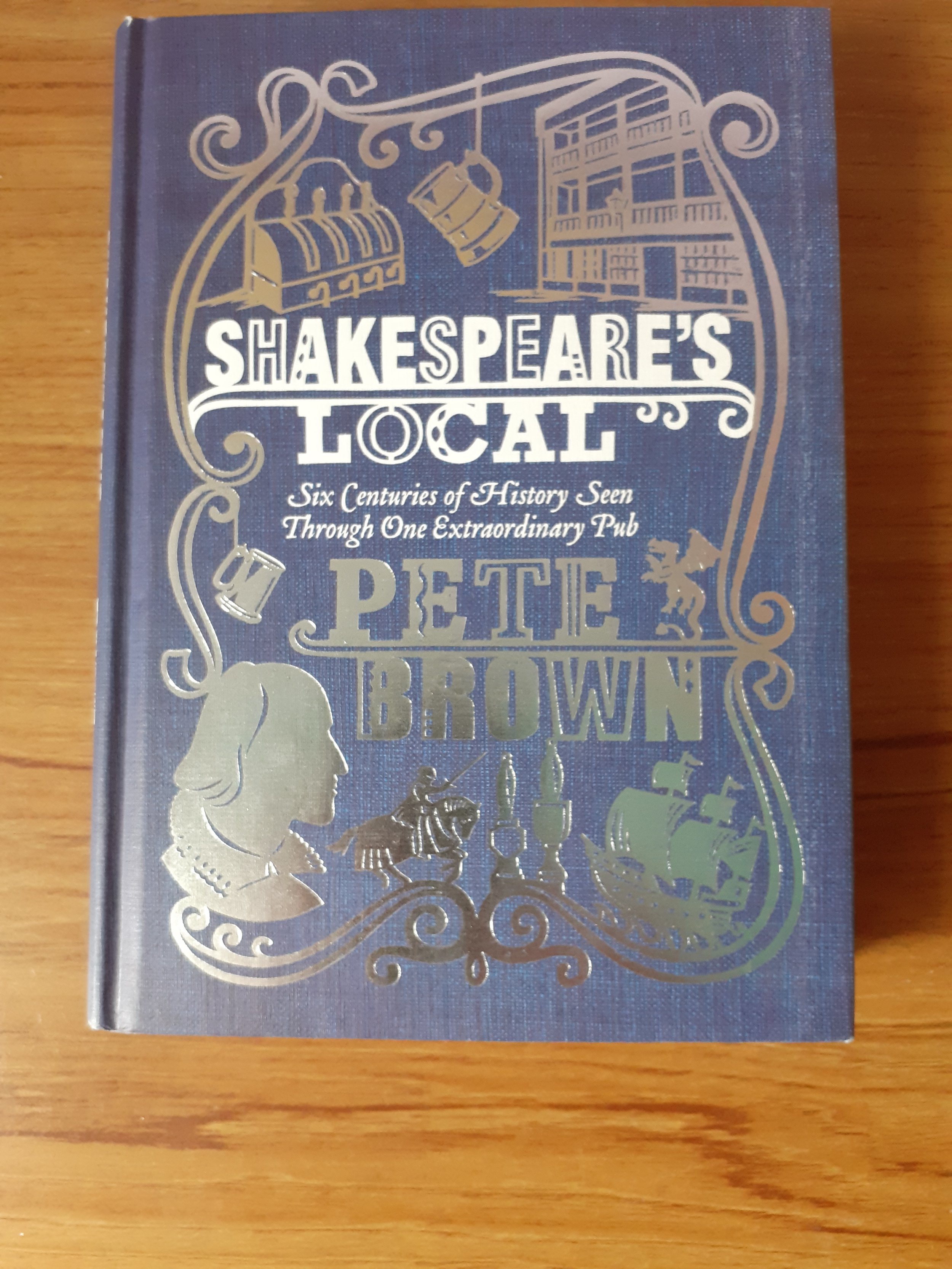
Books on Pubs
A selection of recommended books on pubs and their history. There are books on the social history of pubs and the design of pubs through the ages.
There are also books on visiting pubs and ones recommending pubs to visit.
CAMRA’s Good Beer Guide
Death of the English Pub by Christopher Hutt
Brewers, Brands and the Pubs in their Hands by Tony Thornton
Licensed to Sell by Brandwood, Davidson & Slaughter
And many more
“What contemptible scoundral stole the cork from my lunch ?.”
— W C Fields
Answer: Dorothy L Sayers








